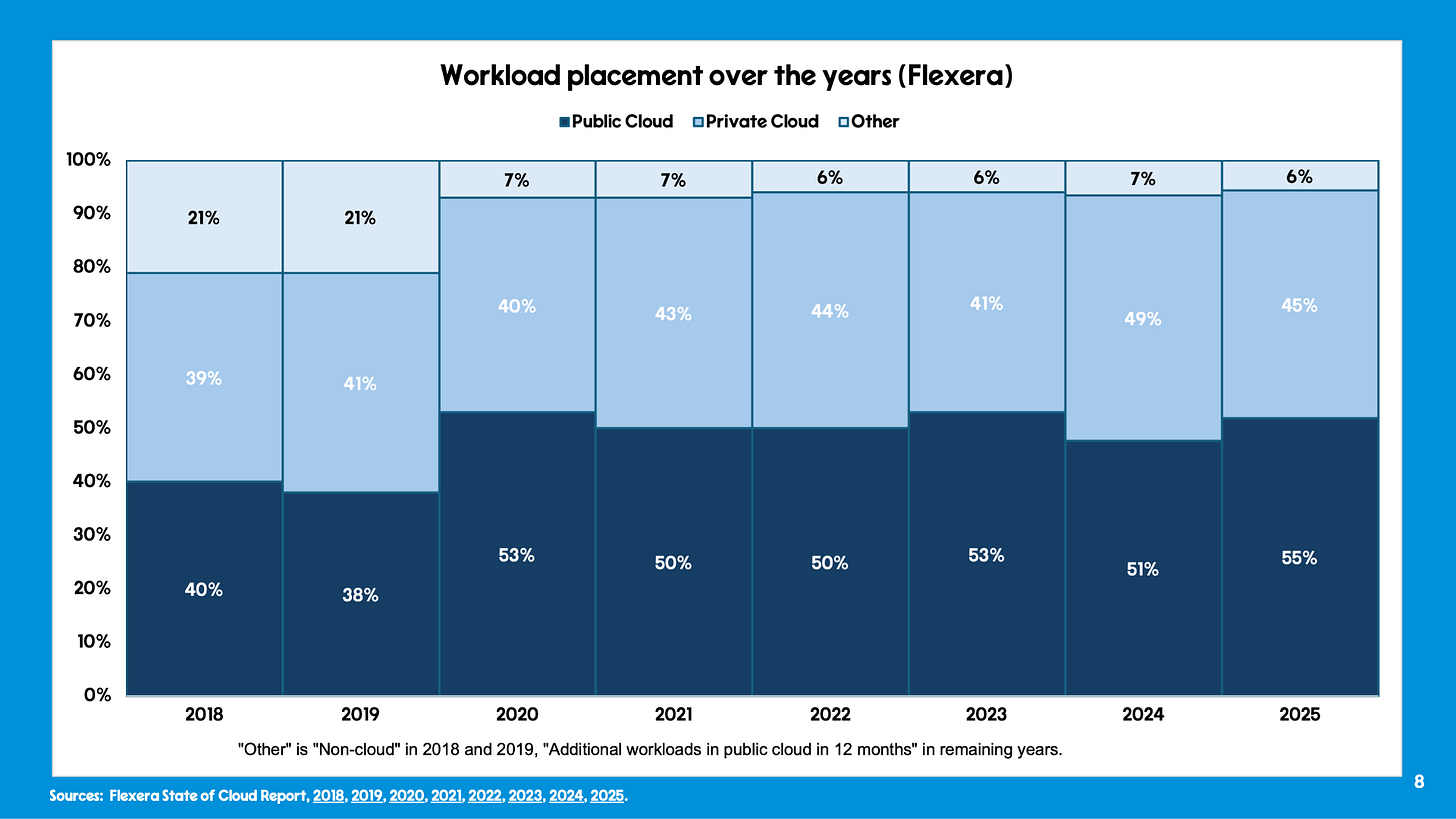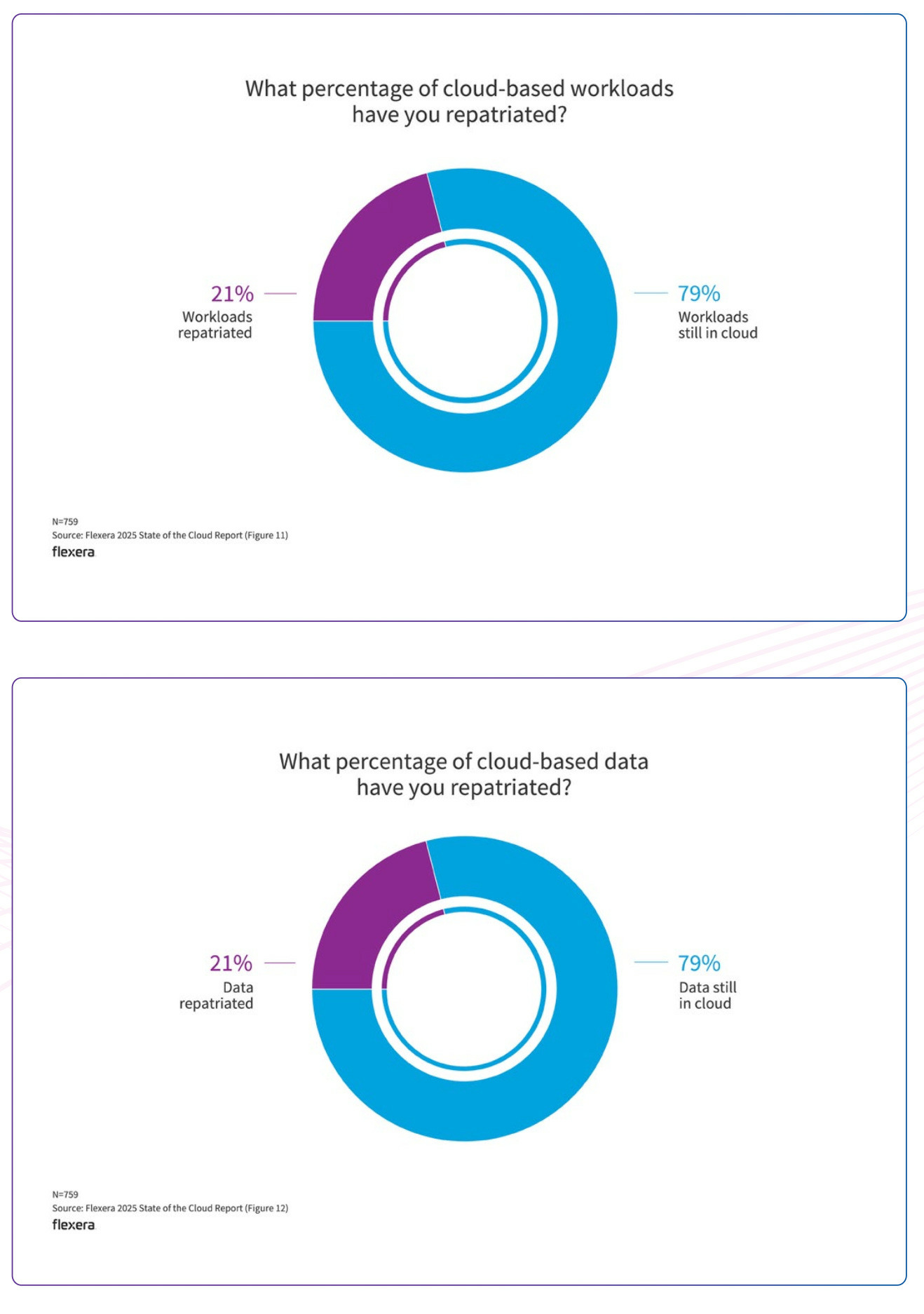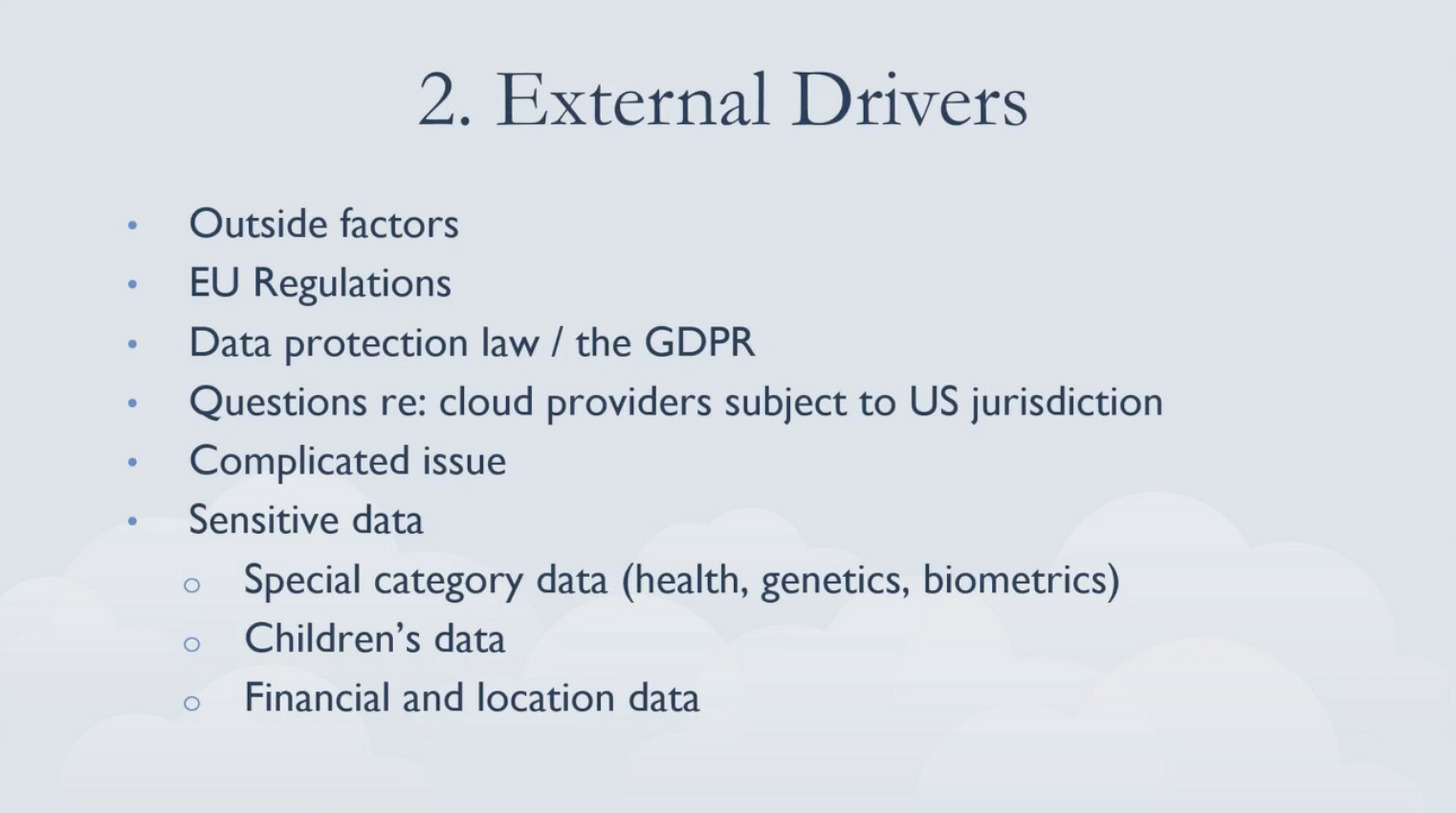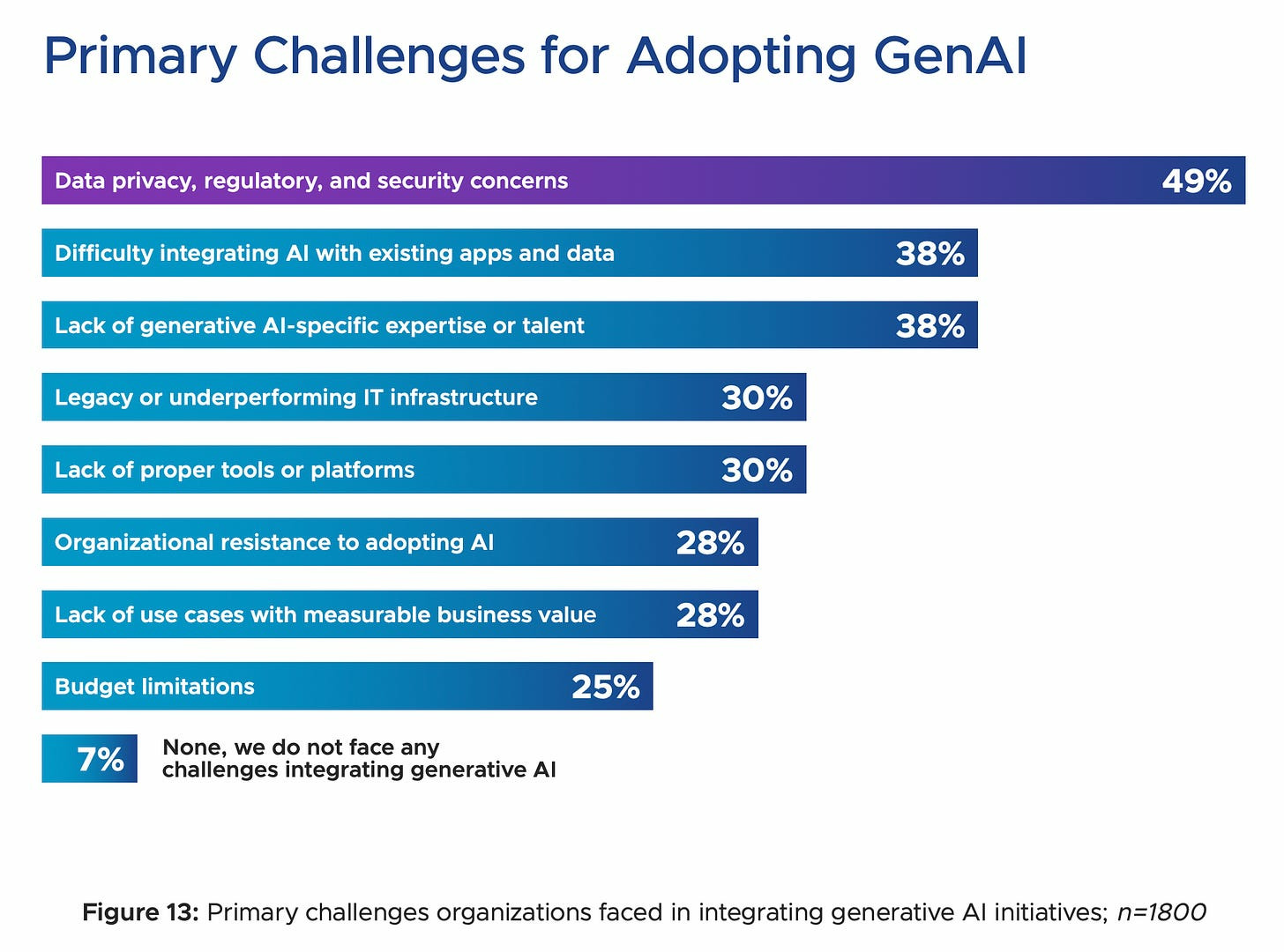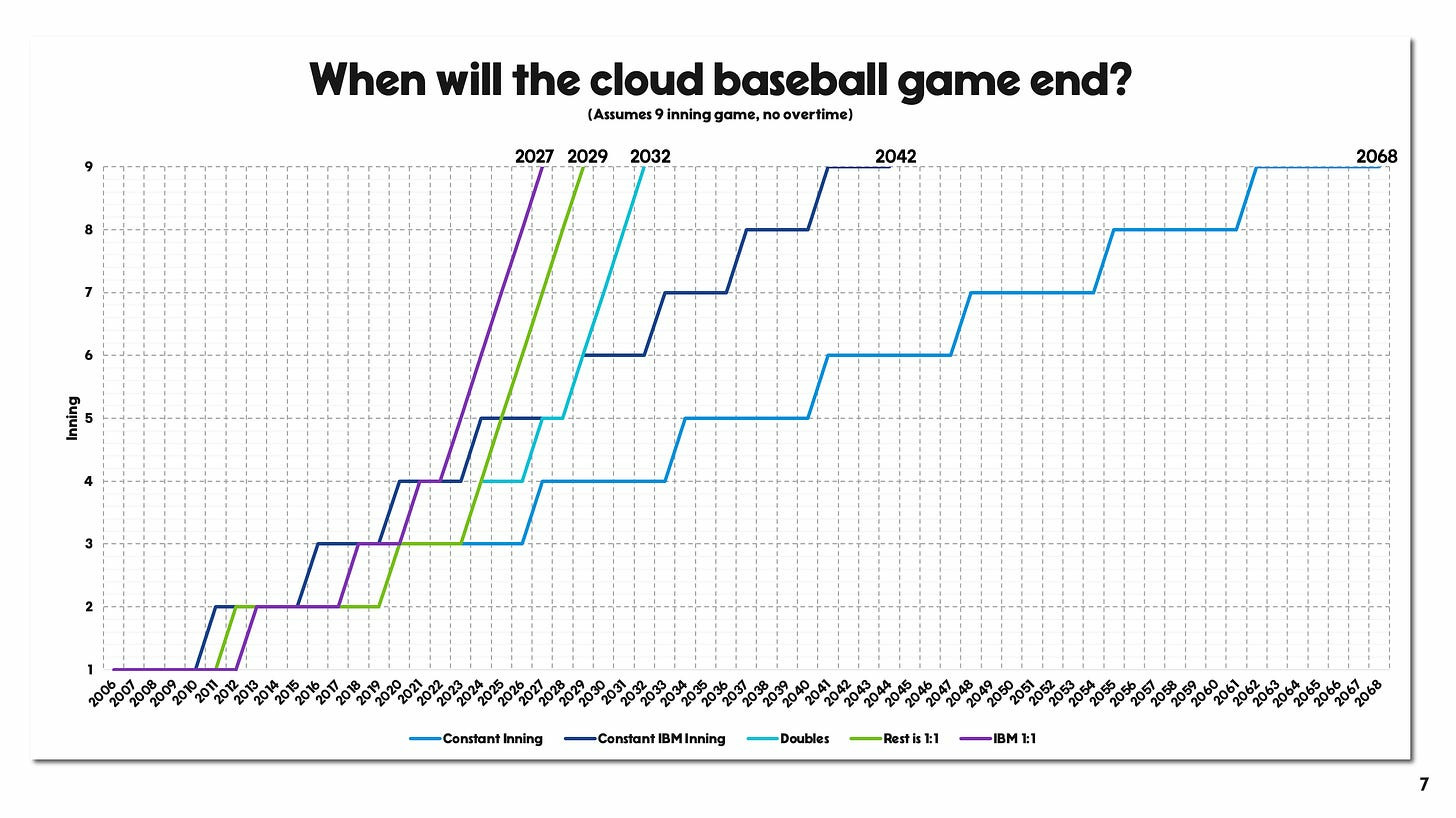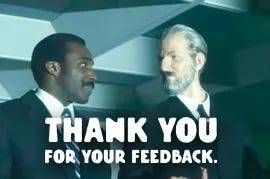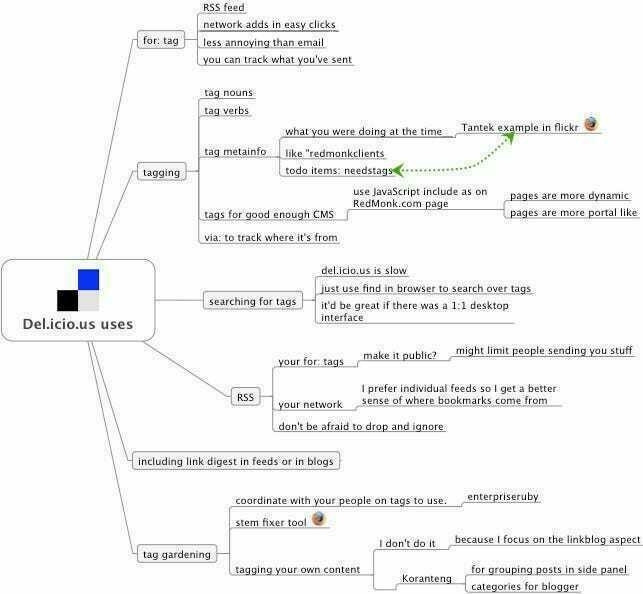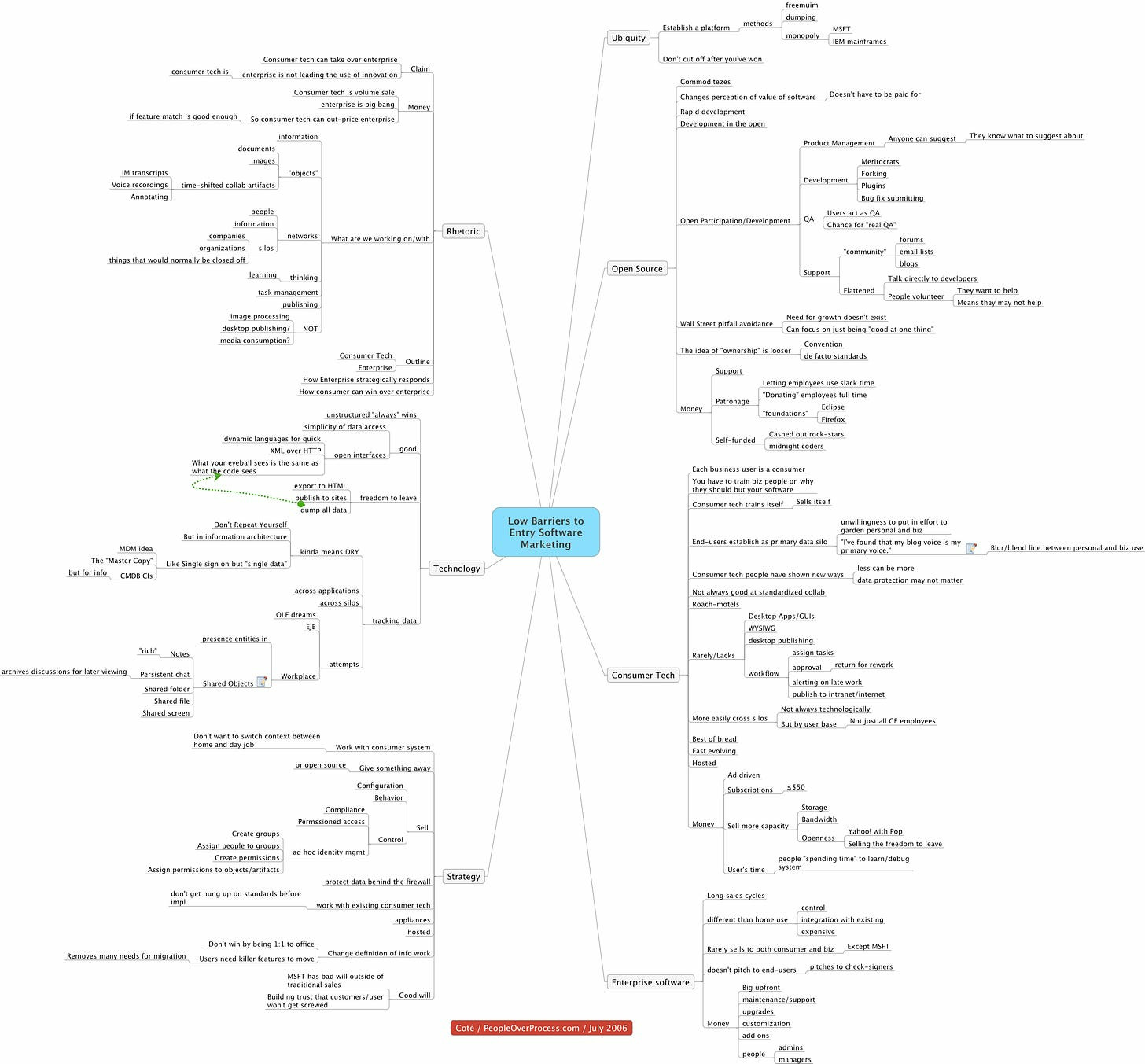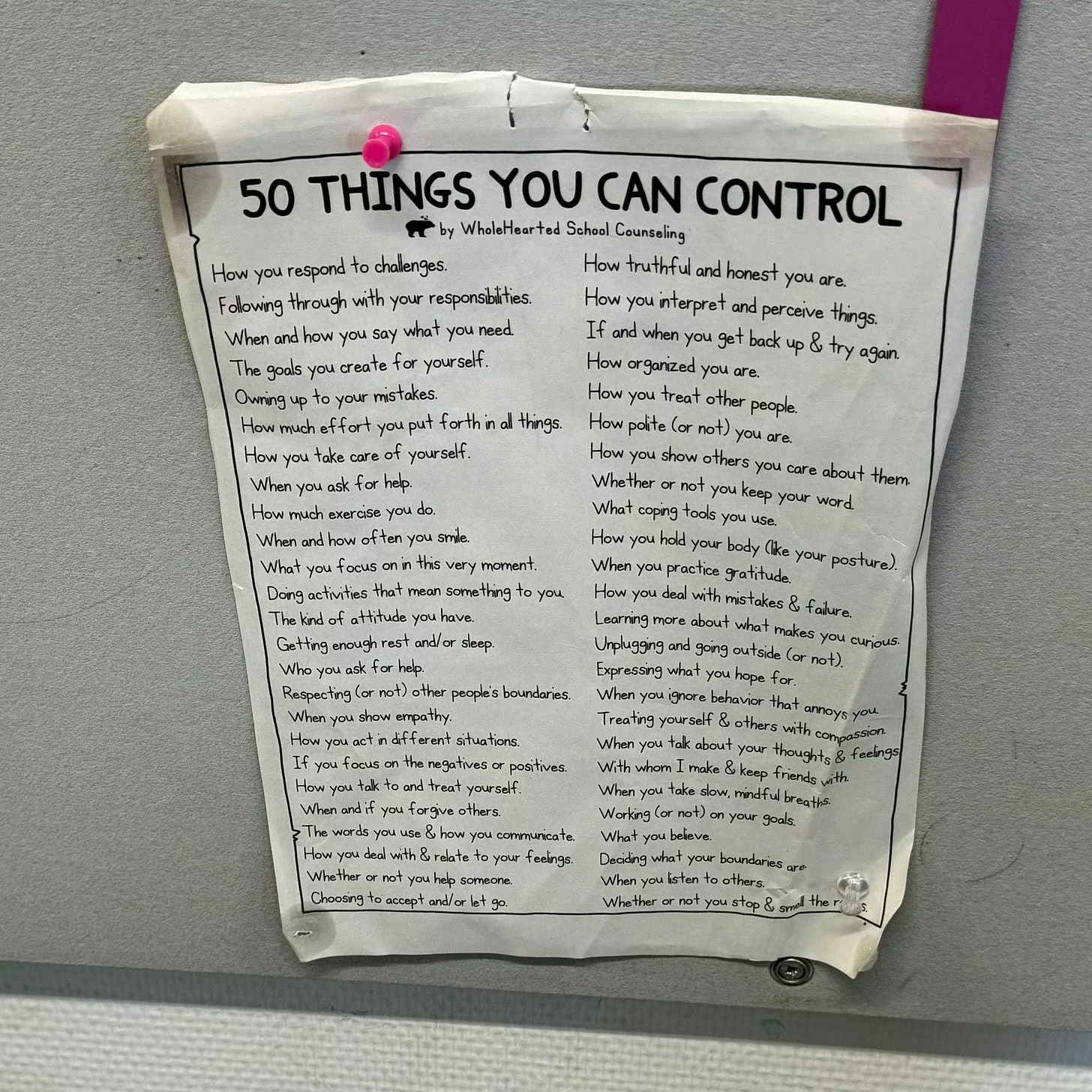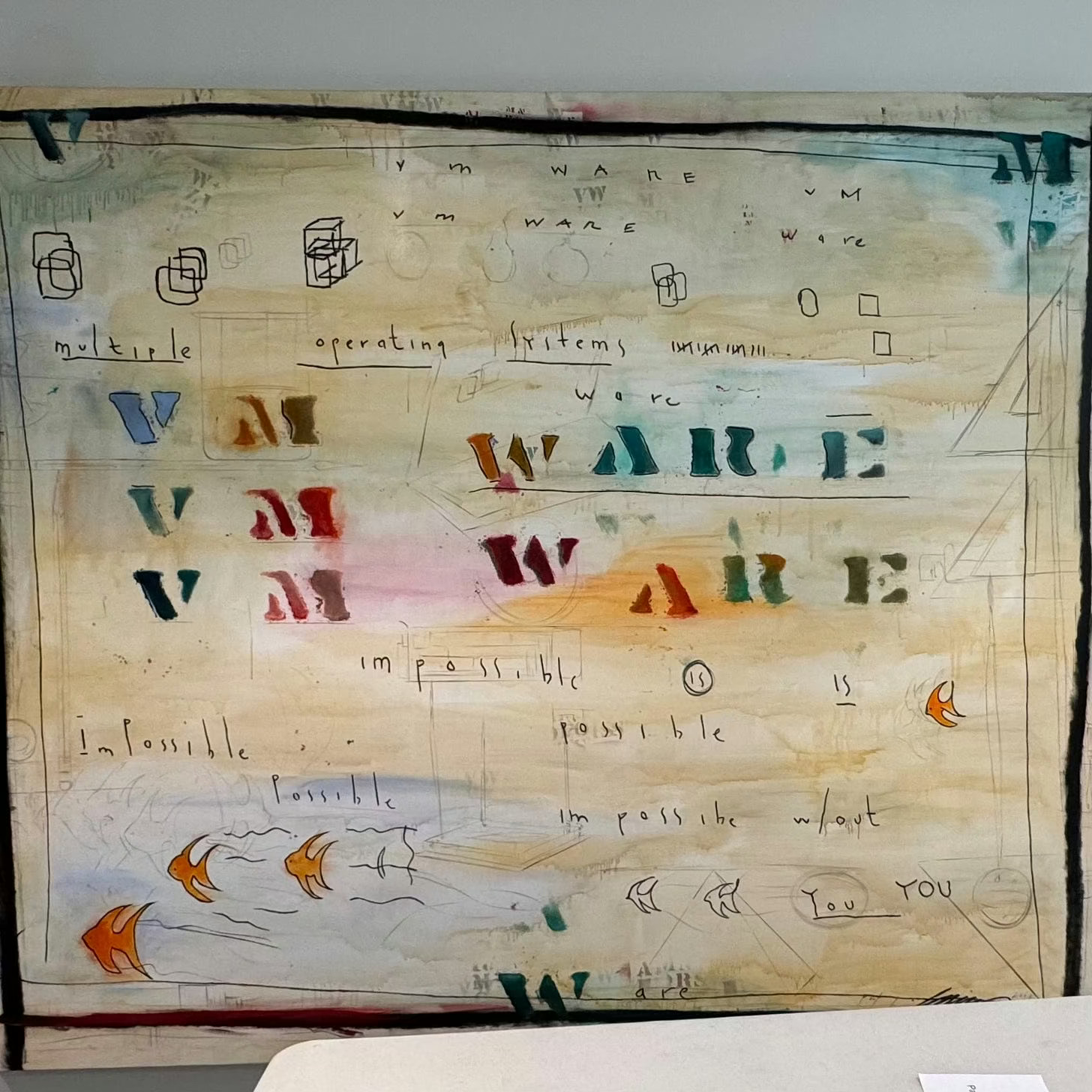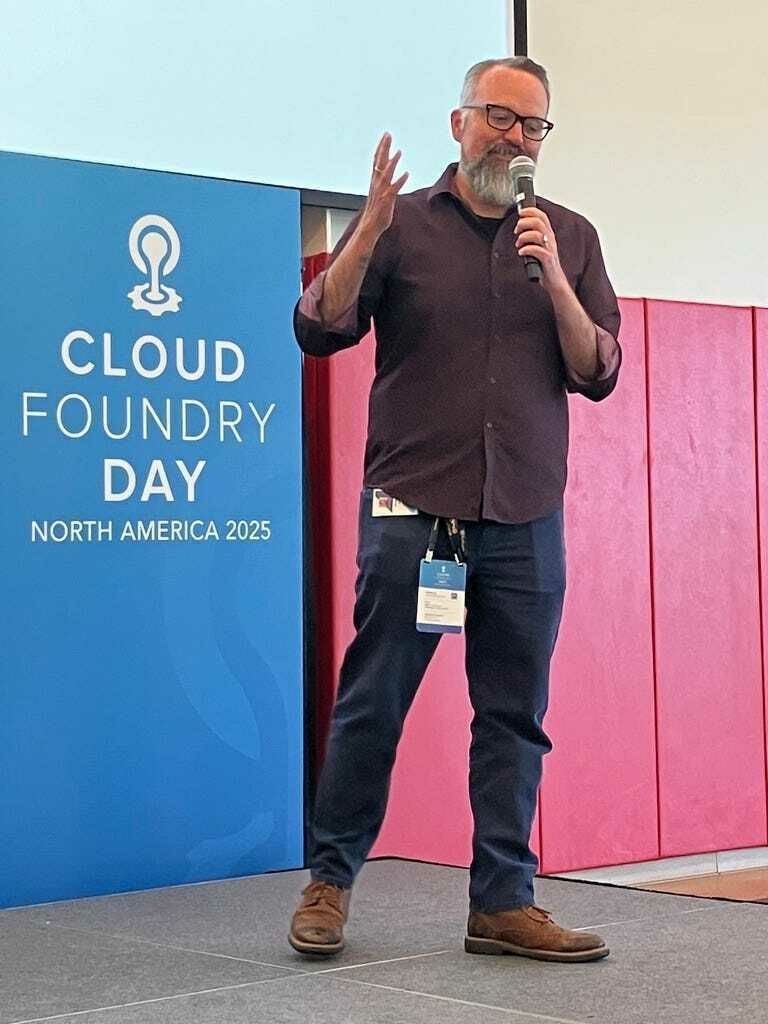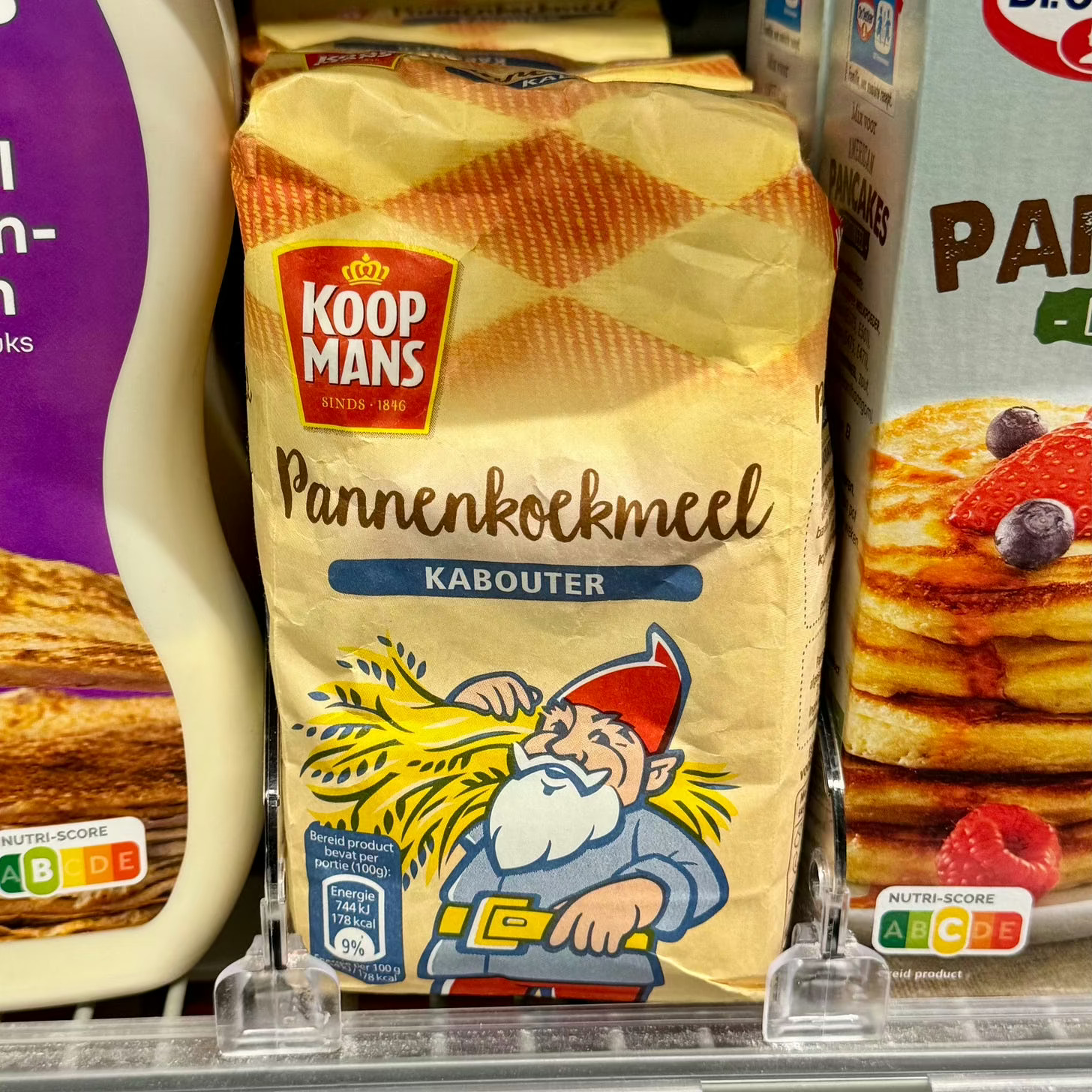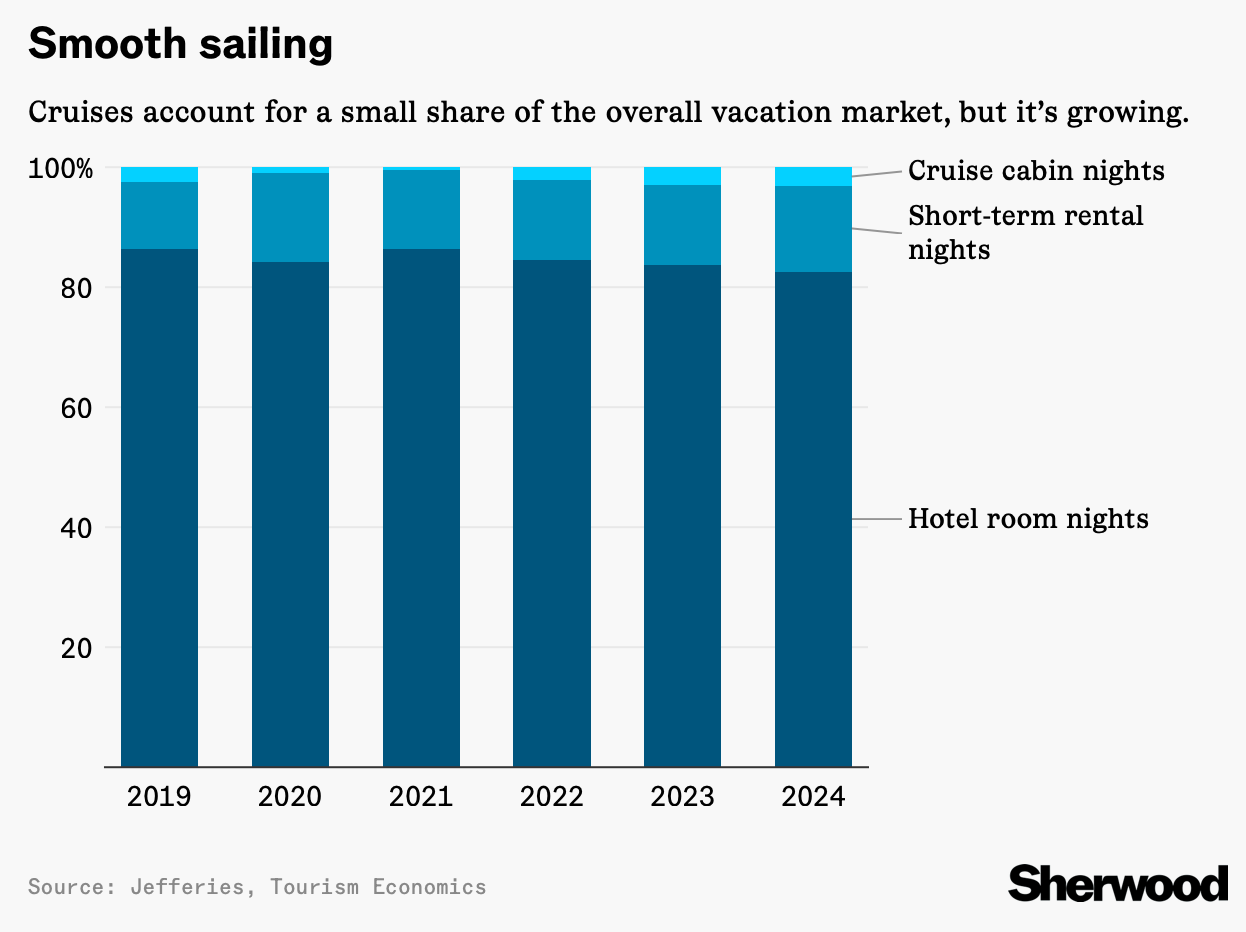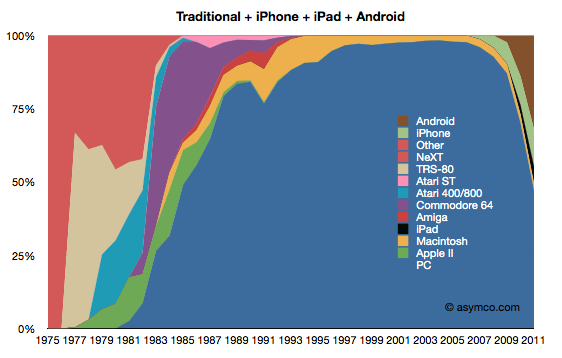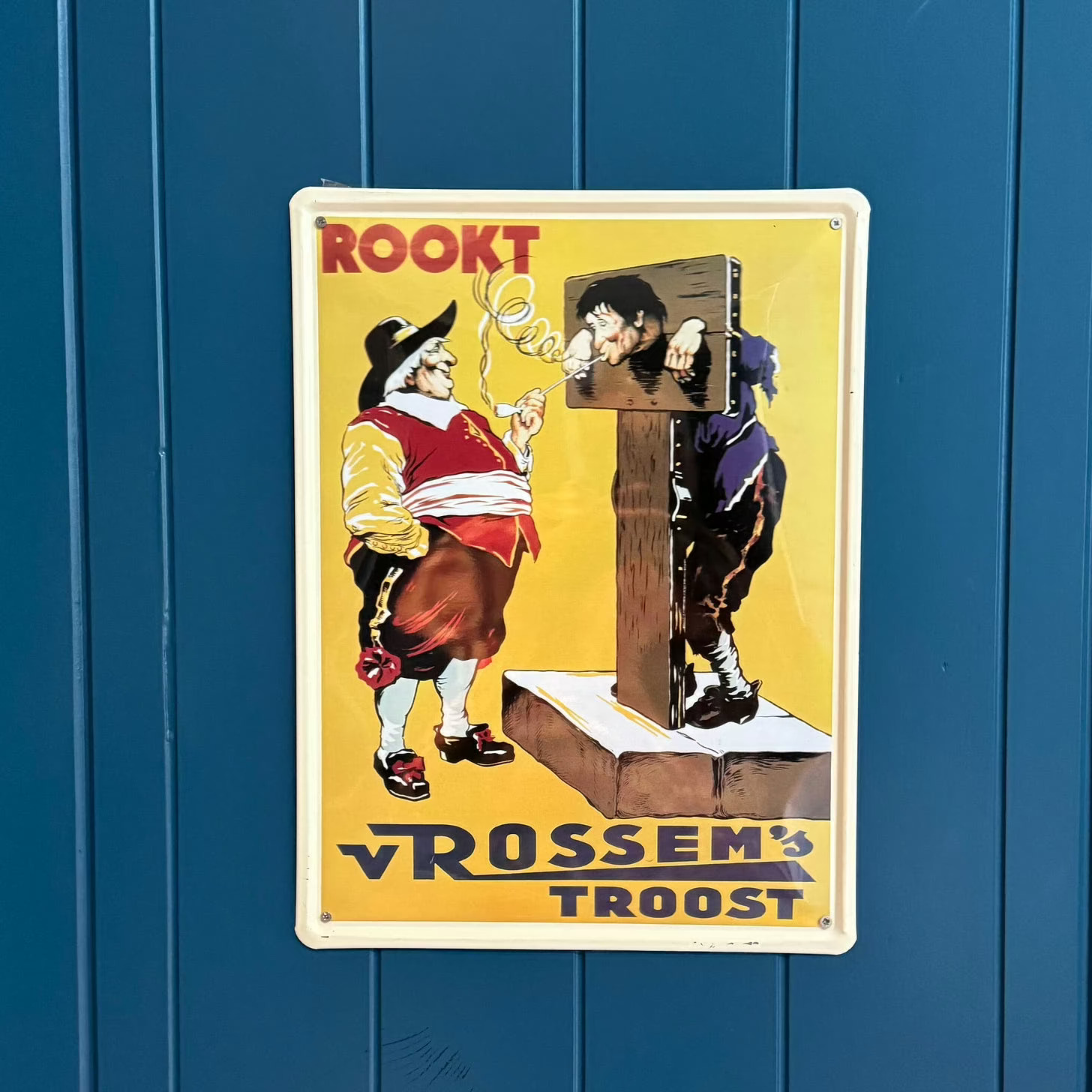Coté
Re: Still a lot of private cloud, numbers of cloud repatriation (higher than I thought)
The Clouds
You know, I’ve never really looked at the Flexera State of Cloud surveys. I think they’re accepted as legit, and they have many years of data to make those multi-year charts I like. Here’s a quick one my favorite question, “where are the apps?”:
So, following up on my “where’s the apps?” post from last Friday, we’re still in the area of 50/50 and definitely very stable.
The first two years look different than the rest. That’s because for 2018 and 2019, the category was “Non-cloud.”1 Then from 2020 to 2025, the top category is “additional workloads in public cloud in 12 months,” running from 7% to 6% in the past 6 years. That feels like it matches the take-away from the Goldman Sachs CIO survey: people’s plans to migrate to public cloud have stalled out, slowed down, etc.
I looked at this because Matt Asay wrote a good reply-piece to my private cloud checkin from last week:
Yet if the private cloud represents the comfortable, status-quo side of enterprise IT, the public cloud is increasingly the experimental, future-facing side. The equilibrium that Coté notes is real, but it masks an important dynamic: Most of the new, industry-defining innovation is happening on public cloud infrastructure. This has been a trend for a long time.
That is the core thing to pay attention to: make sure whatever stack you have keeps up with innovation.
He also has a great least of reasons/motivations to keep your (enterprise) apps in private cloud:
Data gravity and locality: Moving to or replicating massive data sets in a public cloud can be impractical or costly. Keeping those workloads on premises avoids data transfer headaches and expenses.
Ecosystem integration: Many on-premises apps are tightly integrated with ERP systems, legacy services, and low-latency networks. Keeping interdependent systems together in a private environment can improve performance and reliability.
Governance and control: Private clouds offer perceived security and compliance benefits. (Often that safety is more perception than reality, but here we are). Enterprises with strict data governance or regulatory requirements often feel more comfortable keeping sensitive workloads within their own controlled infrastructure.
Familiarity and cost predictability: Organizations have deep expertise in managing their existing environments. For steady-state workloads, owning hardware offers more predictable costs. Enhancing an existing private setup with developer-friendly platforms can deliver flexibility without the uncertainty of public cloud billing spikes.
As I mentioned yesterday, I think the Europeans would add some detail to Governance and Control: because Trump can turn your shit off on a whim, you know, and also get all your data without you knowing.
I mean, like, that would have been weird to have taken too seriously a year ago, but here we are… But after watching the European Sovereign Cloud Day talks yesterday, I’m pretty sure the Europeans are all about building their own clouds, public and private. I don’t get the feeling they think TACO is risk-managed enough strategy there.2
More charts from the Flexera State of Cloud reports, 2018 to 2025
On repatriation, he pulls this from the Flexera state of cloud, 2025 survey: “only about 21% of cloud workloads have been pulled back, far outweighed by new cloud migration and growth.” That is a lot more than I would have thought. Charts:
And, for my main question, “how many apps are on public cloud versus private cloud,” the Flexera surveys have it around 55% public cloud to 45% private cloud, depending on company size.
Relative to your interests
MCP Best Practices - Including unit tests!
alto.index - Transform Your Apple Apps Data into AI-Ready Markdown - Export stuff from your Apple apps. I use Exporter, it’s pretty good.
UK govt study: Copilot AI saved workers 26 minutes a day - Well, that’s one way to do the ROI dance. // “And even using the more modest projected time savings of 4.59 days per employee per year, the £19 per employee per month cost of a Microsoft Copilot Pro subscription in the UK appears to be worthwhile.”
PwC’s AI Agent Survey - New bullet points (or really big text) for slide 3 of your AI pitch deck. // ”Of the 300 senior executives in our May 2025 survey, 88% say their team or business function plans to increase AI-related budgets in the next 12 months due to agentic AI. Seventy-nine percent say AI agents are already being adopted in their companies. And of those adopting AI agents, two-thirds (66%) say that they’re delivering measurable value through increased productivity.”
Tips on prompting ChatGPT for UK technology secretary Peter Kyle - Good tips on working with AIs: (1) use them a lot to build up an intuition of what works, (2) be aware of what they know, the cut off date for training and assume they have general, accepted mainstream knowledge, nothing too obscure, (3) use them for brainstorming and structuring your work. A crude summary: garbage in, garbage out.
Postfacto - Little utility to do team retros, from the Pivotal Labs folks. Open source, all that.
The robot read it
I don’t get the chance, or desire, to read everything. Sometimes, I have the robot read it. Here’s what it says. While enjoyable to read, robot summaries are not endorsements or necessarily my own opinions.
Fungi were once misclassified as plants, but are now offered as a model for artificial intelligence—quietly nourishing ecosystems while decomposing them from within. Somewhere in an English field, Chloe Dalton rescued a baby hare and rewilded her soul, which was not measured by precision sensors.
National Grid and Thoughtworks gave their legacy systems a second life using Change Data Capture and Domain-Driven Design. Meanwhile, a group of engineers procrastinated because their work was boring, vague, and stressful, a revelation that surprised no one but was backed by data.
The euro was meant to unify Europe, but mostly helps Germany borrow cheaply and issue stern looks to the rest. In Brussels, the European Commission moved to loosen enforcement of the newly minted AI Act, quietly shelving liability rules and allowing providers to self-certify as “low risk,” which has never gone wrong before.
Researchers taught one AI to critique another AI’s thoughts so the second could reflect and improve, completing the circle of academic life. And Pavel Samsonov diagnosed the “everything app” as a symptom of “nothing management”—a corporate condition in which leaders agree to everything until the product does nothing at all.
Conferences
I don’t have much in the books at the moment. A list of CFPs I should really submit to. What conferences do you recommend I try and speak at?
SREDay Cologne, June 12th, speaking (10% off with the code CLG10).
Logoff
I’m checking out Gemini and, thus, NotebookML again. So far, so good. I think. This is about the third time I’ve paid for it to try it out. Here’s my two test criteria this time: (1) does it have some personality? For this, I did a lot of coaching in the Saved Info section - this is where you can give it instructions and background that, I assume, gets loaded with every chat, (2) can I upload a shit-ton of content to it and have it actually use it.
I like this switch for a historical word-usage reason too. Back then, people would get really itchy if you said “private cloud” and included everything on-premises. They’d point out that a lot of what wasn't “cloud” - I don't know, automated, self-service, virtualized and containerized? These were the same people who got upset if you said or typed “on-prem.” Now, I don’t think anyone cares about either of those.
Of course, as I like to joke: if you went to American companies and you were like, “hey, what would you say if I suggested you should run all you of your business and store your data in France, under French and EU jurisdiction,” I highly doubt their answer would be “totes McGoats, love it, call up Wipro and let’s migrate that shit!”
The next bottleneck for enterprise AI: data
Lots of links below, plus some sovereign cloud thinking from EU people in the Logoff.
Access to data shouldn’t be holding you can from enterprise AI radicalness
To make enterprise AI useful, you need your data:
Gartner Inc. predicts that organizations will develop 80% of Generative AI (GenAI) business applications on their existing data management platforms by 2028. This approach will reduce the complexity and time required to deliver these applications by 50%.
And, it’d good to spend a lot of time making sure you’ve got good data management and access because “without a unified management approach, adopting these scattered technologies leads to longer delivery times and potential sunk costs for organizations.”
Along with managing your AI usage - hosting your own models or brokering access to others - we’ve bundled together data and data management into the Tanzu Platform. The important part is that you can run Tanzu Platform on-premises, so it’s a lot easier to work with your existing data sets and enterprise-y silos. And, you get full control over your data and apps (see Logoff below for one angle on why that’s important).
And, since this integrates with Spring, you’re Java developers are set to go. But, also all those python apps can work easily with it too: you just point them at the Tanzu Platform AI end-points.
For many organizations - our current customers - there’s something even better. You don’t have to wait for a contract renewal window and then six of 12 months of putting it in place and finally turning it on. All you to have all of this: you’ve got it, pre-approved, already running, paid for, compliant and secure.
Why go through all that migration and procurement hassle when you have what you need?
(If you want to find out if you have the Tanzu Platform at your work, ask me, I’ll find out right quick.)

Maketing Plan
Check out this quick overview of how to put together a (mostly enterprise) software marketing plan. There’s all sorts of methods, forms (in both portrait and landscape mode), but, come on: just use this one as the base, change it if needed, and get on with the work.
Relevant to your interests
Tanzu reboots CloudHealth with enhancements to broaden FinOps use
Broadcom’s Private Cloud Outlook 2025 Report Reveals Definitive Cloud Reset - “More than half (53%) of survey respondents say private cloud is their top priority for deploying new workloads over the next three years, while 69% are considering workload repatriation from public to private cloud, with one-third having already done so. Private cloud is also now a strategic equal for AI and cloud-native apps, with 66% preferring to run container and Kubernetes-based applications on private cloud or a mix of public and private, while 55% prefer private cloud for AI model training, tuning and inference.”
United Airlines CEO: ‘We’re probably doing more AI than anyone’ - Finding what AI is useful for: ”’We started with an enormous number of [AI] use cases, and we whittled it down to the use cases that we want to spend money on,' COO and President John Waldron said during an investor conference last week. Enterprises can’t chase every lead. The share of companies abandoning most of their AI initiatives bumped up to 42% this year, compared to 17% last year, according to analysis from S&P Global Market Intelligence.”
Is AI just going to end up being about programming? - I think there’s about a 30% chance that the answer is yet. // Rather: AI is good at text. If you can get it into text, and you want text as the output: easy win.
Docling: An open-source tool kit for advanced document processing - Looks useful for getting precious text out of the PDF silo, from IBM.
MCP Is the New Control Point in AI—Are CIOs Ready for the Lock-In Battle? - They get the date of the spec’s release wrong (it was November 2024), and it has that Futurum cable TV news vibe, but good points are made, e.g.: “Will MCP remain truly portable, or will each vendor implement its own variation, selectively supporting features that reinforce its ecosystem? Early adopters should insist on full transparency in vendor MCP roadmaps, including plans for multi-cloud portability, third-party agent integration, and auditability of memory objects.” // There’s always someone to call lock-in FUD first - yes, and: good points made for any tech adoption in enterprises.
MCP Is RSS for AI: More Use Cases for Model Context Protocol - I like this: “I’m inclined to think of MCP as RSS for AI.” // Once prompts are used as intended - to be user initiated activity in the UI, we’ll see if things evolve. Think of an MCP prompt as adding a new button, or command to the UI…sort of. Most MCP things now are “tools” reading data or writing data, the AI puts some text into the tool, some text comes out. But, the tool user is the AI, not the human. Of course, the human can tell the AI to use it. We have demos of configuring Cloud Foundry this way. An MCP prompt’s user it meant to be a human, directly typing or clicking something. This might be too nuanced of a distinction and turn out not to be useful. The MCP clients, like Claude need better implementations of it (it should start with auto-complete slash commands, the example in the MCP spec!). // Another point: the MCP spec is making a big semantic gamble on the distinction between tools, prompts, and resources. Looking at all the tools so far, the others aren’t needed to get the functionality you want, but they do seem like a cleaner design. The people writing the MCP Servers will determine if those extra semantics (prompts and resources) are useful, needed.
What do people do all day? - Possible “can AI can replace my job?” heuristic: how long do you spend sitting at work?
Just because Silicon Valley is pumped to make this junk doesn’t mean people will buy it - Not a fan of AI glasses.
Using ChatGPT as a therapist - …people like it. Also, for the cost/benefit analysis, and the constant availability, it makes sense. // As with self-driving cars, this is also an example where we expect 100% accuracy and zero-risk from the AI and ignore the fact that humans (human therapists in this example) are not 100% perfect…usually far from it. // This is maybe the number one not-tech, not-work usage I hear about from normies.
Beyond Launch - Establish platform metrics early on. Not only to report on, but to mind-program people what to expect and how to think of ROI. Otherwise, the only way they’ll metric your platform is by “is it cheaper than it was last time.” // ‘In enterprise environments, silence gets interpreted as stagnation. Stakeholders will assume “if I’m not hearing about progress, there probably isn’t any” - and they’re usually right!’
Nine Rules for Evaluating New Technology - It should be cheaper, better, and not cause a lot of bullshit.
How to Lead an All-Hands After Delivering Bad News - “Create a shared mental model to make sure your team understands what the new context means for how they work together.” // That and, people also want to know: how will I know if I’m next and what I can do to prevent it?
Red Hat Summit 2025: AI, Virtualization, Hybrid Cloud, And The Future Of Enterprise IT
Cloud Repatriation is Getting Complicated - The repatriation thought-leading is taking hold. Even the bomb thrower is soaking in the ambient thought leadering!
Google Study: 65% of Developer Time Wasted Without Platforms - Better get a platform. // ‘Intriguingly, 86% of the survey’s respondents also said they believe that "platform engineering is essential to realizing the full business value of AI. " // “At the same time, a vast majority of companies view AI as a catalyst for advancing platform engineering, with 94% of organizations identifying AI to be ‘Critical’ or ‘Important’ to the future of platform engineering.”’
Reinvent the Wheel - ”Reinvent for insight. Reuse for impact.” // Yes, and: so long as the value of insight isn’t outweighed by the cost and risk of having to rewire all your day two stuff: how ops people manage and run it in production.
A New Look, A Clear Path - New IDC branding, logo, etc.
Donald Trump’s digital landgrab - File under “sovereign cloud”: “The state department is now claiming otherwise: if you’re on the internet and using a service provided by a US tech company, they say, then Donald Trump sets the rules. The US is quietly declaring sovereignty over cyberspace and expecting the world to acquiesce, making an unprecedented digital landgrab in the name of freedom.”
Moody Folkloric Fantasy – The Beast of Black Keep - This guy makes great, little adventures, here’s a new one.
Making books that fly, fold, wrap, hide, pop up, twist, and turn : books for kids to make - …and adults.
On the pleasure of reading private notebooks - Diaries (“journals”) and notebooks are the best, I love them as well. // “I think this is because our genuine thoughts (and interests) are more detailed and alive than the simulations we have of what we should say (or be interested in). When we think no one listens, we relax into the genuine. I’ve been told, repeatedly, that I hide my most interesting thoughts in the footnotes.” // “This is, I think, at the root of why I like reading private notes so much. There are so few places where we get to be close to other people and see the messy humanity they carry behind the identities they have polished for society life.” // There’s a certain kind of “comfort in knowing you’re not the only one” therapy in that.

Wastebook
“unhappens” Here.
JSON repatriation.
We were promised sentient computes, and all we got was call center automation.
Whatever the size, you probably only need half that sandwich.
“I need you to be helpful, not tell me everything that is wrong.”
“If my mom wanted good art on her fridge, she could’ve purchased reprints of works by Vermeer, Lichtenstein, Wyeth, etc. But she didn’t want good art – she wanted my art.”
“‘Paul Graham has published a blog post where he is wrong about something’ is not a news item so much as expected background radiation of contemporary life.” maya.land.
the soulless colleague, Val Thoermer.
Emotional support ice-pack.

Logoff
I’m watching The European Sovereign Cloud Day today. The opening talk by David Michels is really going hard on the Trump means you need to get out of the US cloud market. Two quotes so far:
“Will the US government hand over your data without informing you?”
“Does Donald Trump have a big red button her can press to cut you off from your cloud service?”
What kind of data should you be FUD’ing about? Here’s a slide:
That’s the data, pushing that “big red button” is something most people probably don’t think of. The US government can just tell American companies to shut off access, you know, like impose sanctions. It’s already happened to the International Criminal Court (ICC) Chief Prosecutor Karim Khan, whose email was shut off by Microsoft:
The blocked access, enforced by Microsoft, means Khan can no longer read messages sent to his official account. The decision, directly tied to U.S. foreign policy, reportedly underscores the vulnerability of Dutch public institutions that depend on American tech infrastructure. The incident has reignited political debate about the extent to which the Netherlands can—and should—continue relying on Microsoft.
That stuff makes cloud a lot different for Europeans…and any “sovereign” state or group.
Of course, the same applies to any country. The EU drives all those little cookie pop-ups, but also means I can use USB-C cables for all my devices. I don’t mind those so much, really.
Still a lot - private cloud check-in, Spring 2025
Where are the workloads?
Let’s check in on how much private there is nowadays. I think it’s somewhere in the range of 40% to 60% of workloads1 globally. If you narrow down to “enterprises” (let’s say organization that have 5,000, even 10,000 employees), my sense is that the number goes way up, maybe 70%.
The way I think about the question “how much private cloud is there?” is “where are all the applications and services running.” I think most people think of that question in terms of revenue, market-share - a way of thinking that my 401(k) is way into as a sense-making tool, but doesn’t reflect how people should make strategic choices in IT.
And, yes, I’m obviously biased, swimming around in big, C.R.E.A.M-y pools of WYSIATI. I work at a company that is focused on building and selling private PaaS. That’s why I spend so much time gathering charts and anecdata on private cloud.
Oh, also, if you want a PaaS - or, “platform” if you prefer - you should use ours, the Tanzu Platform. It’s proven, used by all sort of enterprises, and, you know, just works.
Back to pondering…
My last private cloud check-in was July of 2024. The conclusions haven’t changed much since then, which part of the conclusion, I guess.
Here’s the charts and analysis I currently use at the tail end of Spring 2025, plus some new items from this week.
The Charts
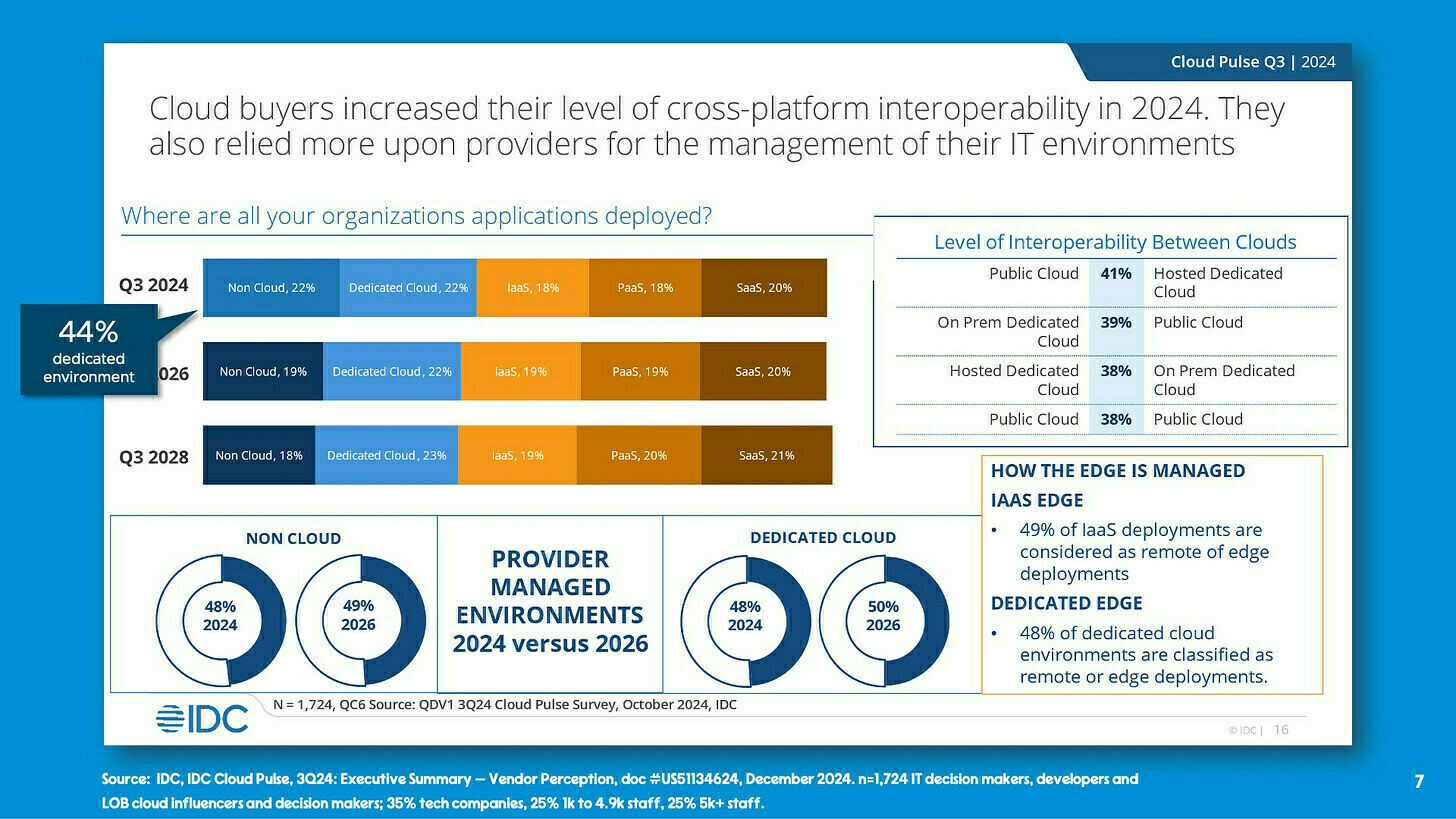
A chart like this has a lot of nuance. It’s the most recent IDC CloudPulse, one of the few analyst surveys/reports that asks the question “where are the workloads?” They don’t like to call it “private cloud,” and instead prefer “dedicated environment.” I assume the Q3 2028 numbers are estimates - IDC’s valuation would be a lot higher if they had a time machine.
They don’t like you using older data, which makes sense. Their methodology can change over the years. Here’s a screenshot of that represents my thinking, synthesis, and sloppy reconciling of surveys over the years:
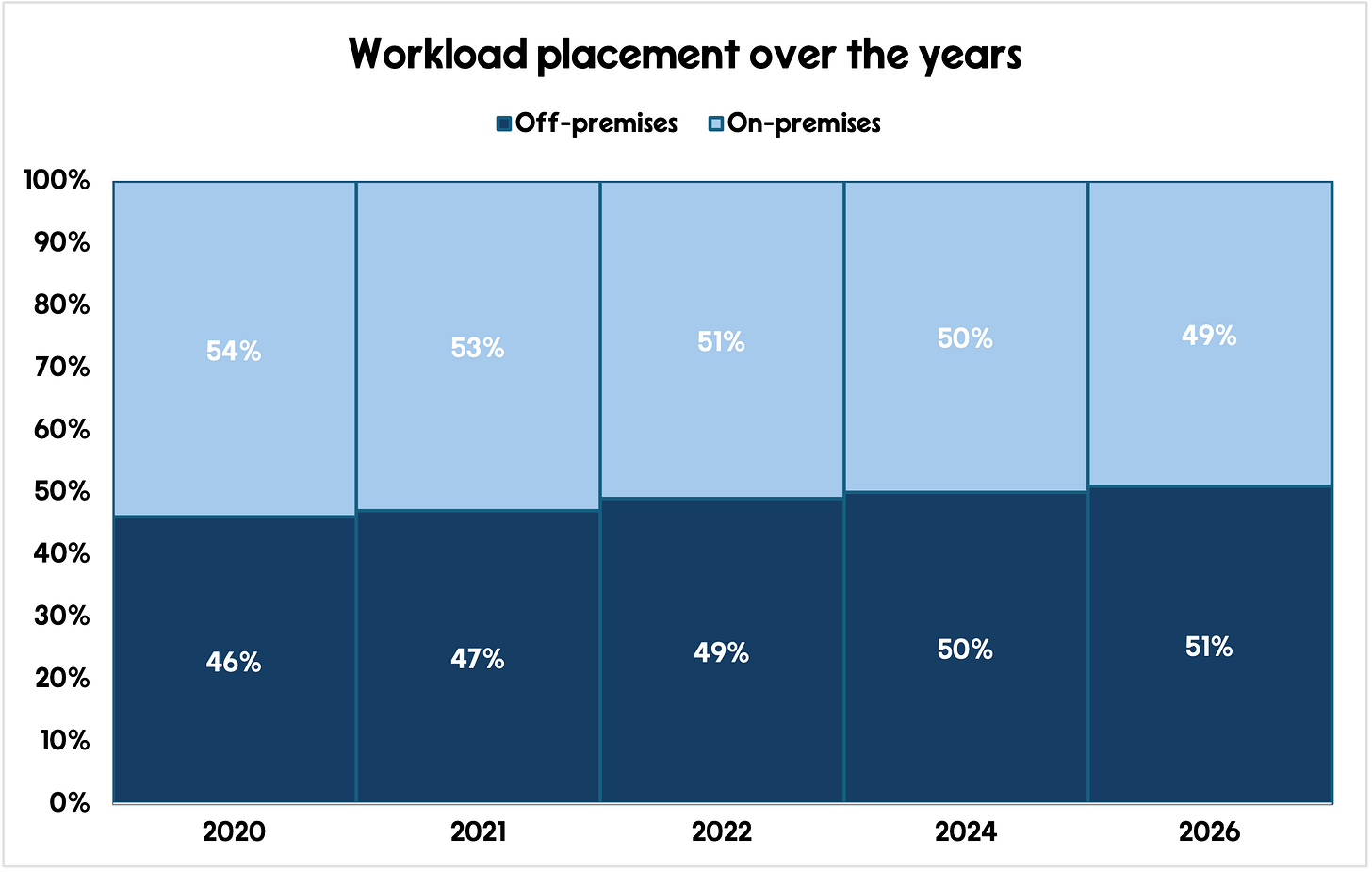
Here, you see a steady state. We could call it 50/50.
That steady state matches up with a Goldman survey of CIO’s plans for cloud migration. I haven’t found an update on this, so it’s same as last time:
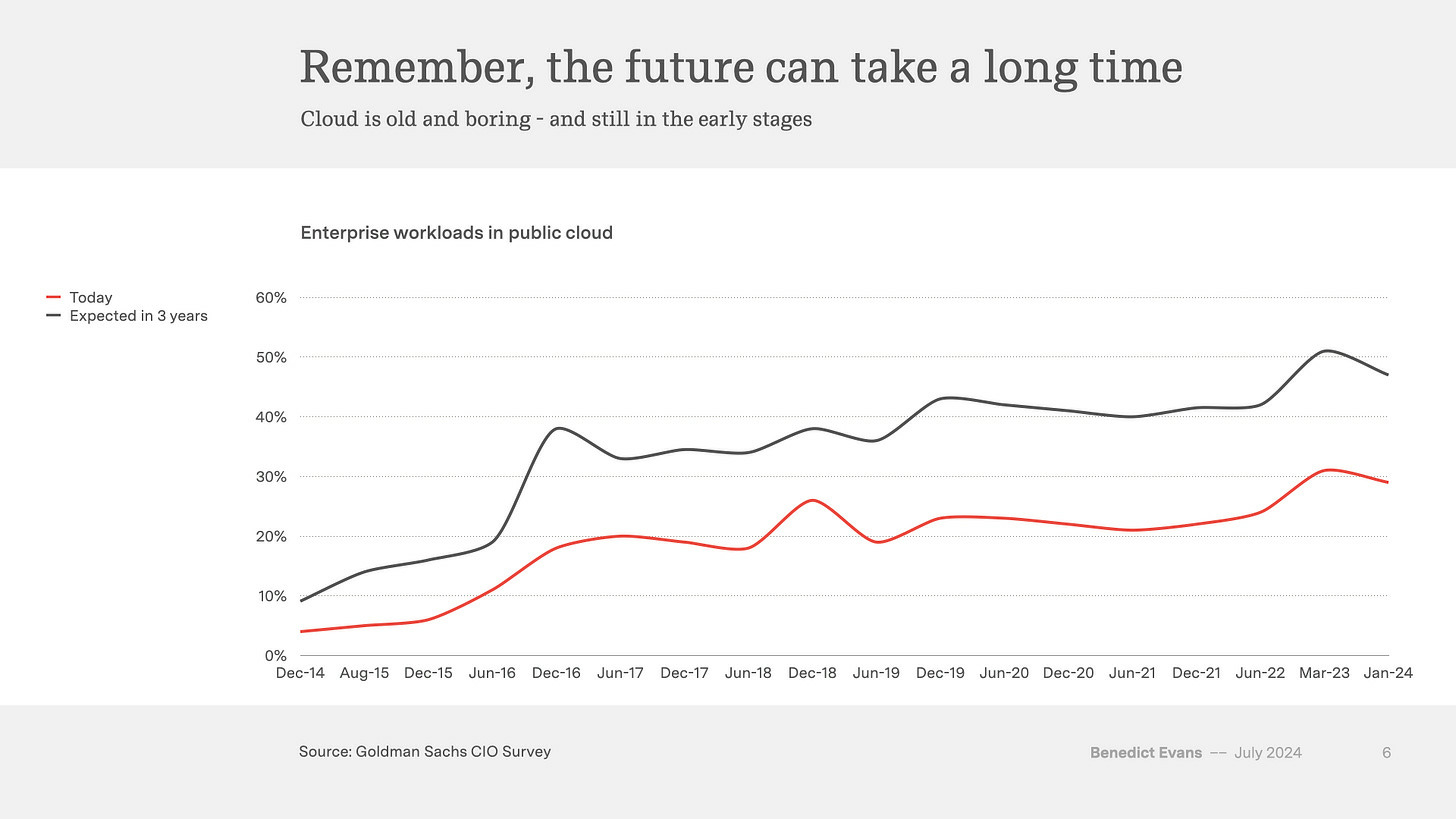
What you see in that chart is that CIOs are always going on about moving more workloads to public cloud, but they move a lot less than planned.2 The workloads stay where they are. And here, in January 2024, the % of workloads in private cloud was ~30%. That’s a lot less than the IDC numbers.
Now, I’ve tried to track down the PDFs for these surveys to understand them better, check methodology and definitions, etc., but never found them. Slides Benedict is reliable enough though, so I’ll trust he (and/or his intern) has done the work. As such, I use this chart more as vibe-check for charts than a primary ponder.
There’s a few more charts (this one in particular, and this one is pretty good too) that you should check out if you care about all this. I went over a full round-up of them at cfgmgmtcamp back in February as well.
What the ^F50*$ are up to
And then, there’s this anecdata:
[W]e do have a lot of large customers that are running in AWS in the cloud today, and a huge number of them still have massive amounts of their estate on-premise. And so there’s a huge amount of growth available there. You can even take our largest customers, many of them only have 10, 20, 30, or 40 percent of their workloads in the cloud.
I put this under anecdata because the scoping isn’t specified and you can really go all confirmation bias on it. You can read it as saying that in large enterprises, anywhere between 60% and 90% of their workloads are running on private cloud. Of course, Garman might be talking about just two customers, or 500, or 50. Who knows! (And, what about the ones that are not AWS customers?)
Also, stating numbers like is about making sure you’re building in future growth into your share price. The point of the above is saying “and we’re going to get those workloads, think of all the future revenue!” - a variation on the “your margin is my opportunity” bit.
Moving back to private cloud
And then, we have Corey Quinn, this week on cloud repatriation:
Five years ago, I fairly confidently stated that Cloud Repatriation Isn’t a Thing, and I by and large stand by what I wrote. That said, it’s 2025, and the story has changed…
He goes on to list the reasons you’d move workloads from public cloud back to private cloud: lowering costs, especially for companies that are no longer in ZiRP-growth mode and data sovereignty.
This last part is the Trump effect - despite possible TACO safe-guards, does the rest of the world (business and government) want to run their business under the jurisdiction of Trump? Just like the US tech-folk go nuts when the EU calls the shots: nope. (Sure do like that USB-C on my Apple devices tho…)
Now, you have to be careful with repatriation surveys. What you want to know is not if they are doing (or even planning) repatriation, but how many workloads they’re moving (or plan to move). There’s a big difference between repatriating one or two workloads (like DHH or, as Corey recalls, Dropbox), or hundreds.
What caught my attention in Corey’s post though was that the repatriation thought-leader’ing has reached him, and enough for him to post about it! He could be making fun of AWS, but instead he’s talking about enterprise cloud repatriation.
The relevant Barclays survey is from April 2024, was promoted by Michael Dell in the same month, and showed up at VMware Explore in August, 2024. That thought-leader’ing has legs.3
(Checking out the original PDF is worth it for other fun charts, if you’re into these kinds of things.)
March 6 to April 4, 2025 Broadcom Survey
My employer has a new survey out on the private cloud use question (here’s a direct PDF link).
First, one of the charts on reparation:
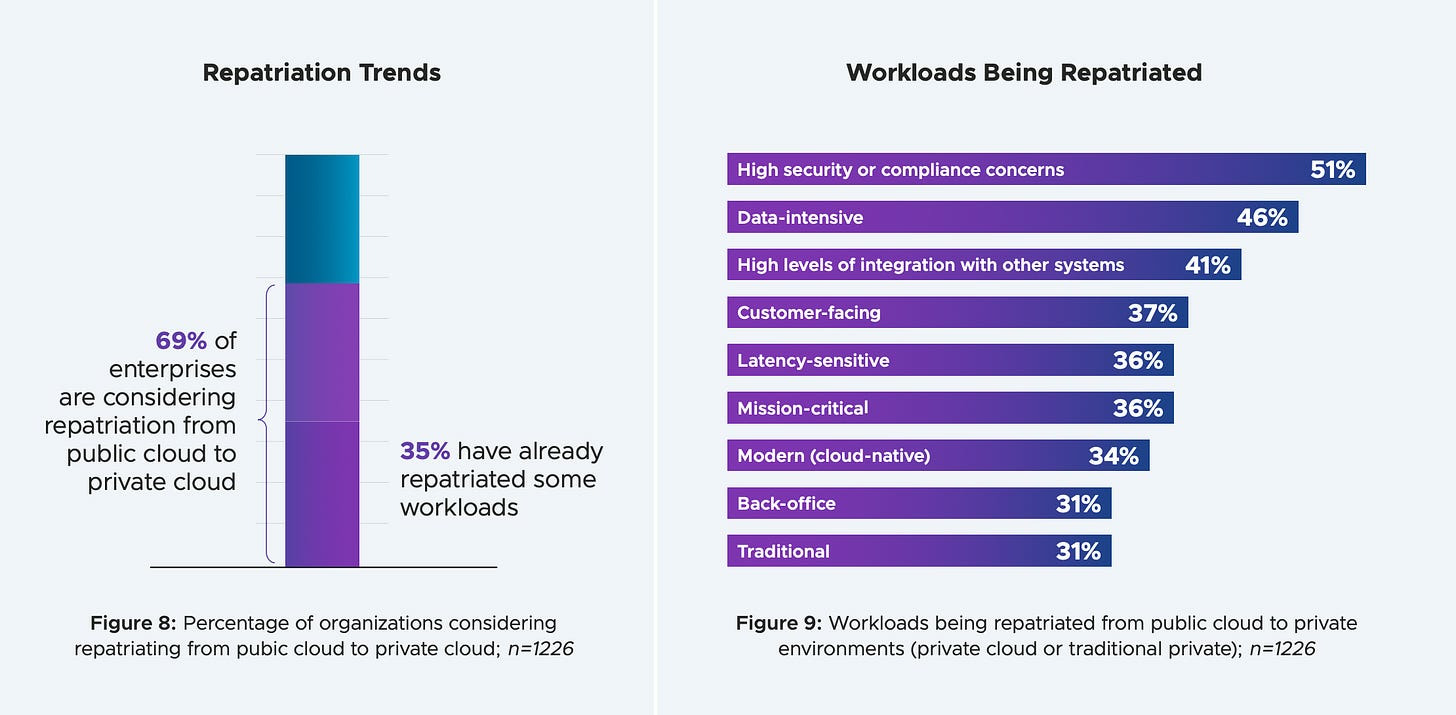
I like it when a chart breaks down into categories as seen here: what are the characteristics/needs of the workloads being moved. Security is always on-top of the list (see below), and then the next two are about working with existing enterprise apps and systems. The forth - customer facing - is important because it tells you that the apps are important for the business.
The new workloads
Now, my “where are the workloads” focus is about where the existing workloads are. From the above, it feels like the answer has been the same (40% or 50% or 60% - whatever, you get the idea) for a while.
One reason is probably “because it works fine, don't screw with it.” Another reason might be because there hasn’t really been many new app types since, maybe, the 2010’s. In those years, enterprises was freaking the fuck out about “digital” and were rushing to get better at software, driving a bunch of new apps which dragged in a bunch of new infrastructure.
The survey doesn’t address my core question (how many workloads are on private cloud versus public cloud), but it does cover sentiments and plans for app placement. For example, as Raakhee Mistry summarizes:
When asked to identify each of their top cloud priorities, the most cited 3-year priority was to build new workloads in private cloud environments (53%)… 84% of organizations are using private cloud for both traditional and modern applications.
What those workloads are isn’t specified. But, from what people are saying AI is driving a lot of new workloads. After a year of PoC’ing and puttering around with python, followed by some planning and annual budget begging in Fall 2025, 2026 might be the year where enterprises start adding AI into a lot existing apps and making new apps - we’ll see!
The survey gives us a couple of interesting bits on this AI growth workload pondering. First, what are the “challenges” for doing AI? You can reframe “challenges” as “needs” or, simply, “requirements”4:
Security is always the #1 in concern. It’s both true and virtue-signaling: “What? Nah, we’re not worried about security,” said no IT survey respondent ever.
The second bar down is more interesting. The need to integrate with existing apps and data shows that people are not thinking of net-new, stand alone application, but ways of augmenting/improving their existing apps and, thus, businesses. This is great! It means they’re looking to get better at the bulk of what they do, not just play in the margins like making videos of a crooning grizzly bears in a lounge to, presumably, sell more Instagram cuff-links.
It’s also easy to imagine that with AI we’ll encounter data gravity again. That is, all that data and existing apps and services are on the private cloud (and will stay there), so your new apps will need some way to connect with them. See the surveys above for the important of integrating with data and existing apps!
This think pairs up with the last chart I use now, one from another Broadcom/VMware sponsored report in December 2025:
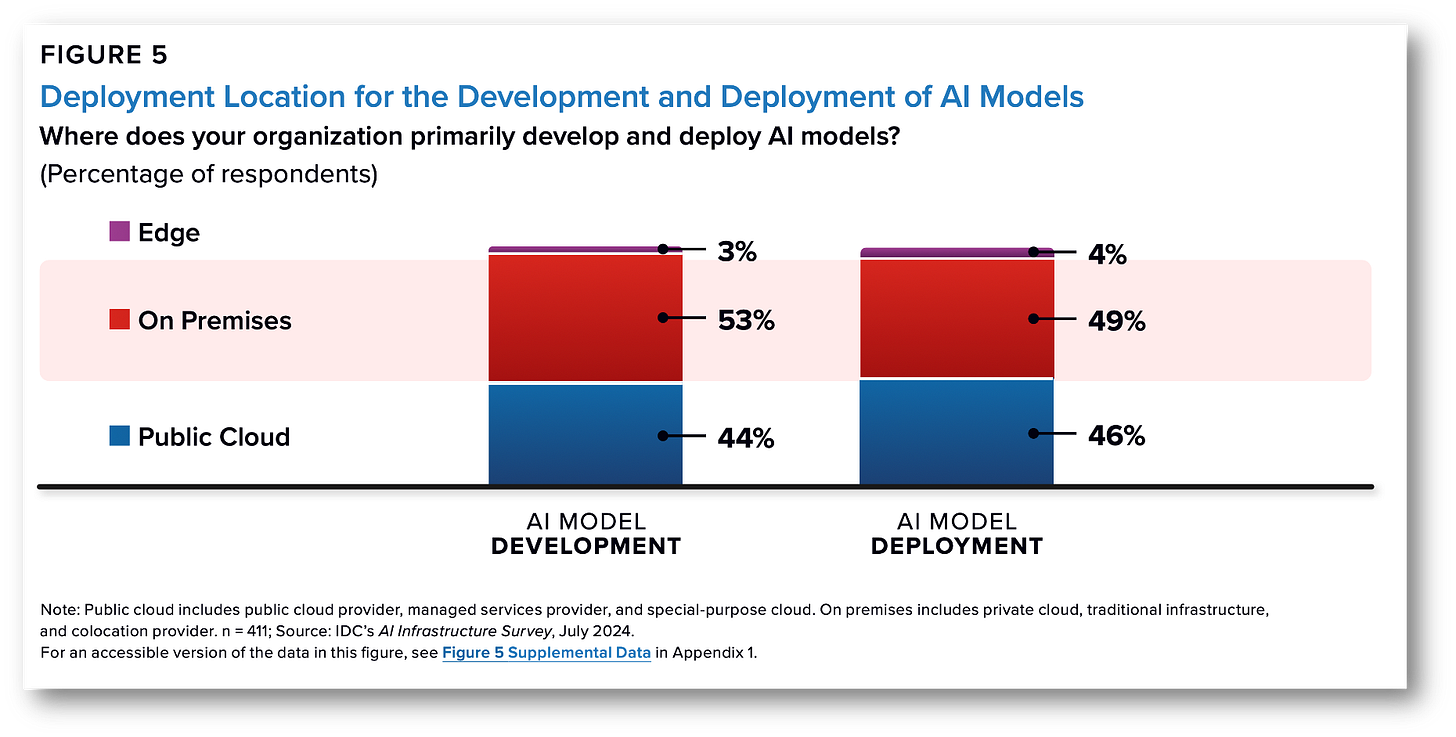
There, you can see that people are planning on deploying ~50% of their models on-premises. That’s not apps, sure, but if the model is on-premises, chances are high the apps will be there too.
The Beginning of the Last Inning
So, for many of years now, the number of workloads on private cloud seems to be holding steady. There’s a strong possibility that a new type of application, AI, will drive interest in doing a lot of new applications. For those AI apps, data and access to existing enterprise goop is needed. Some people are pondering repatriation, at least enough for Corey to skip the opportunity to take more pot-shots at Kubernetes.
It must all mean something!
I joked in that February talk that the cloud people love talking about being in the first inning of a baseball game. Based on thorough joke-analysis of these “early in the first inning” quotes over the years, I estimated that this means the public cloud baseball game will wrap either in 2027 or 2068, with 2042 being somewhere in the middle:
If the game ended now, we’d be at a 50/50 split or so, bouncing around lazily over the years. Based on things in the last days of Spring 2025, I’m guessing we’re finally further into the last inning than just barely into the first.
Logoff
That’s it for today. I have three things to self-promote, though:
My post first post in a series on writing MCP Servers for D&D. Hopefully the second will be up very soon, corporate copy editors and The New Stack CMS’ers willing.
I was super thrilled to interview Taegan Goddard on Whitney and I’s podcast. I really like his, I don’t know, blog, Political Wire and admire him as a indie publishing empire.
And, this week’s Software Defined Talk is fun, take a listen.
//
Oh, also, I asked ChatGPT to “make a picture of what you think I look like in a style you think I would I appreciate,” and it has a sort of Marc Maron if he were a hedge-wizard feel, don’t you think?
…enjoy your weekend.
Hey, The Kids, I’m sorry to be old. I use the term “workloads” to mean “stuff you run on your computers.” If it feels weird, sub-in the word “applications,” but keep in mind it should be something more like, “applications and services.”
As some of my snarkier enterprise friends like to say, cloud migrations are a 1 and half CIO job. The first CIO will launch the initiative, but leave after three years before it’s done, require the next one to spend half their time on it. Of course, it could turn into a 2 CIO job.
Here's some further commentary on the Barclays chart from Larry Walsh, August, 2024: “The problem with the 83% figure is that it represents companies, not workloads. So if 83% of enterprises decide to move one workload from the public cloud to their local infrastructure, the number remains true.”
Also, “shit that keeps the CIO up at night.”
Dark leisure, eating sausage and vodka before a morning run
Relative to your interests
Looks like it’s all AI except one link. Can you find it?
Your First Spring AI 1.0 Application - Making a full AI-driven app with Spring.
How does ChatGPT work? What is AI, really? - Good overview of the basics.
Agentic AI delivers measurable value to early adopters - "More than one-quarter of respondents are planning for [AI] budget increases of at least 26% in the next 12 months. Nearly three-quarters of senior leaders believe…”
OpenAI consumer pivot shows AI isn’t B2B - Where are the business successes and mass adoption? // “Who cares if consumers use AI for helping a friend plan a road trip, informal therapy sessions, or astrological readings? The stakes are low…”
The luxury of saying no. - “Most people don’t get to say no. Not really. They’re not debating whether to use AI on principle. They’re trying to figure out how to keep their job without surrendering their judgment or drowning in tasks that keep multiplying while headcount shrinks. For most people, using an LLM isn’t an abdication of thought–it’s often the only way to carve out enough time and focus to do any real thinking at all.”
Dark Leisure - ”in many orgs, there is too little incentive to pass on these productivity gains by telling your manager: “i found this neat tool that lets me do 8h of work in 3h! give me more work!”” // Some “real workers of the world unite” vibes.
Azul CTO: Java at 30 Still Rules Enterprise Dev - Yes, and: Azul must have set a compare goal for this FY to get a, checks notes, “shit ton” of coverage.
The robot read it
I don’t read all the links I come across. Like the below, sometimes I have the AI read it. You’ve been warned.
At SAP Sapphire, executives polished their AI pitch with Joule, a copilot now destined to appear in everything from HR workflows to humanoid robots, while declaring the death of complexity through “suite-as-a-service.” CIOs, meanwhile, were urged to craft enterprise-wide SAP roadmaps that include cost-risk forecasting, hyperscaler alignment, and internal AI investments—despite no clear ROI, mounting transformation fatigue, and the uncomfortable feeling that they’ve been here before.
Nadia Asparouhova explained that the most powerful cultural ideas are “anti-memes”—things that work precisely because no one understands them, a claim ironically promoted via glossy press coverage. And Ed Zitron warned that modern companies are being run by “business idiots” who climb the ranks by appearing competent while doing nothing of consequence, suggesting that the true anti-meme may be merit itself.
Wastebook
“the skills as defined in the first sentence are small fingers – which is not a skill.” iPhone-talk.
“Are ‘friends’ electric? You won’t need to hold them in your hand. You’ll just carry a little coffin with a ghost in it that talks to you.” Warren Ellis.
“I respect your privacy and time.” Angela Winter.
Eating sausage and drinking vodka with Russian general, then early morning jogging. You Won, Now What?
Conferences
Events I’ll either be speaking at or just attending.
SREDay Cologne, June 12th, speaking (10% off with the code CLG10).
Logoff
That’s it for now.
Now's a great time to rediscover PaaS
My recap of Cloud Foundry Day is up on the Tanzu blog: check it out!
I gave an opening talk at Cloud Foundry Day last week. I ended up shortening it a lot and, of course, I didn’t exactly give the talk I’d written down. Here’s the script I wrote for myself. It goes over the opportunity the Cloud Foundry community has right now. I gave a talk later in the day that more systematically made the case below.
Well, thanks for coming. To put in the effort and expense, and the time: y'all in the room here are definitely die-hard, lifers in the Cloud Foundry community. And it's thanks to you (and those who couldn't make it but wanted to), that have been in the community so long, that we're here and have given the users of our platform such a great experience all these years. So, thanks for that. You should be pleased with yourself, proud - all that.
It can be hard to stick in this community - some people and organizations have given up, bedazzled by perceived substitutes for a great developer platform. Some of us in the community have been bedazzled here and there. But the result of that bedazzlement - and, you know, I'm talking about Kubernetes, obviously - is often befuddlement. You're not supposed to say negative things about competition at things like this, or, really, even acknowledge that they exist! It's necessary, maybe even cathartic for some, though, to acknowledge the elephant we've been living with for a long time.
Here's what I think: Kubernetes is finally boring, and we can get back to Cloud Foundry being exciting. As I'll talk about later today in my longer talk, I think we need to get back to thinking about Cloud Foundry as a developer platform, not an operations platform. If we re-position our thinking around that, we'll bring our beloved platform to more and more people. If we really focus on that mind-shift as a community, supporting and amplifying each other, we might even need to book a bigger space next year.
And that's what I want to pitch this community on. We should be supporting each other more. Boosting each other's efforts, and being loud about the success of people who use Cloud Foundry - the pleasure they take in it.
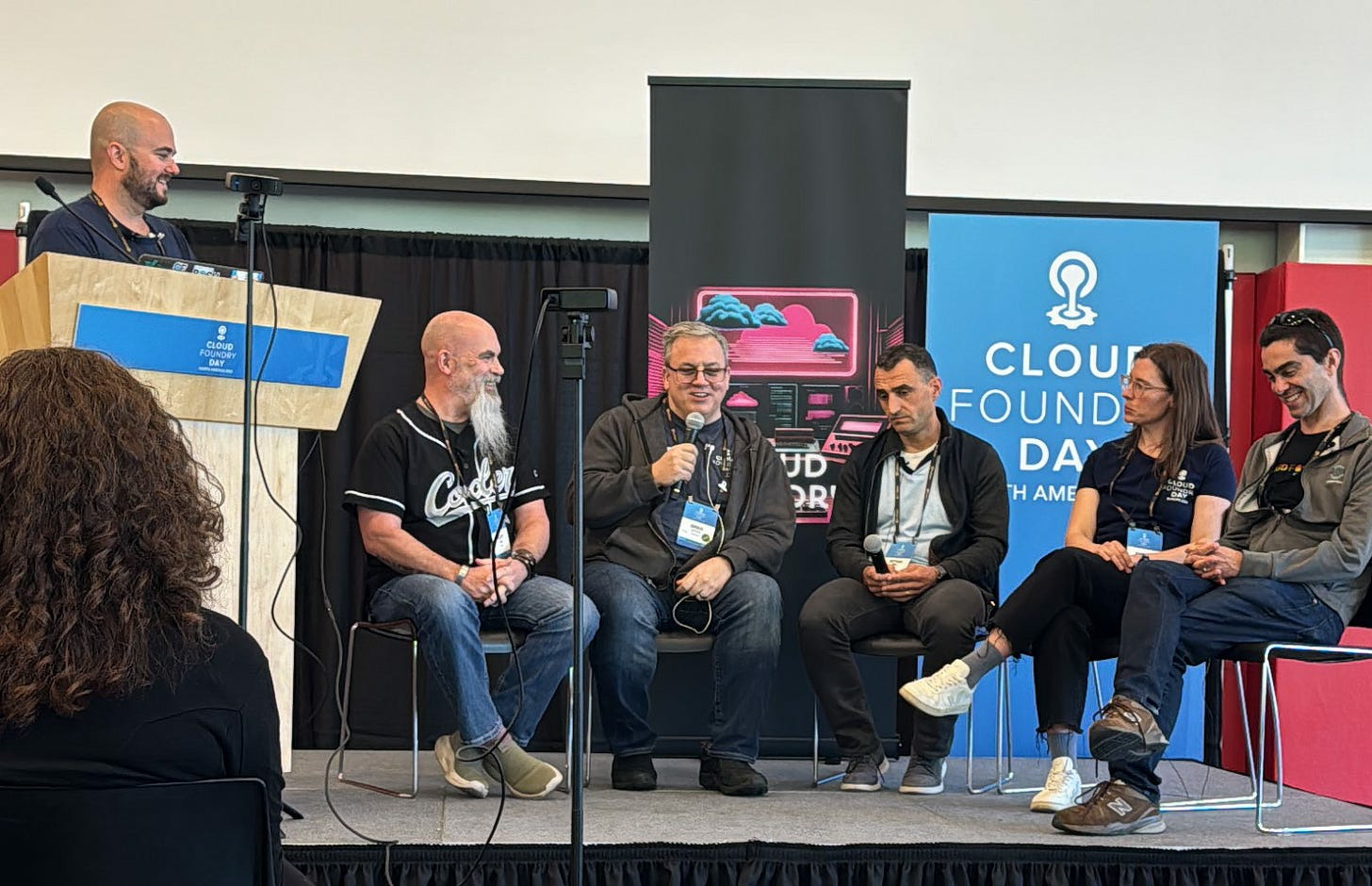
I think too many people have forgotten how good it is, what a real developer platform looks like and feels like to use.
We've all heard the stories. There's a corporate initiative to replace Cloud Foundry. The developers love Cloud Foundry and aren't sure why there's a need to change, but it's out of their hands. A year goes by: you get a PoC, and then you move to more apps…how do we move our apps and data to this new thing? How do we get developers to learn how to package up their apps and make their apps manageable on the new platform? Turns out we need to build a platform now (guess they actually meant it when they Tweeted that Kubernetes isn't a platform, it's a platform for building platforms), better get some platform engineering too…so we need to transform the ops people, yet again. And what's this "product management" business we need to do? Also, we now need to maintain that platform - right after we launch it, the developers start asking for new features. Have you heard about AI? Oh, and have you seen the new budget requests?
And so on.
Some organizations succeed here, and that's great for them. Gold-star stickers all around. Other ones, we end up hearing about years later and they haven't done much. What's bizarre is that everything was working just fine. The developers were happy, they were shipping, the platform ran just fine, and the business was improving.
I think the broader "market" has wised up to this cycle. Or, at least, experienced it.
That's our first opportunity, and why I think it's important for us to work together more. People want a platform and they're discovering that they don't have one anymore.
Cloud Foundry is a platform and it works, right now, and it's been working for a long time.
The next two opportunities are associated with private cloud.
In my mind, "private cloud" more means "not the hyperscalers" than just "on-premises." You can run it on-premises or managed by a service provider, whatever. It means you have more control of your stack. IDC has this delightful phrase - "dedicated environment" - that captures it well.
The thing with private cloud is that it's always been there. If you get all wrapped up in revenue numbers of public cloud, you'll miss that about 50% of applications run on private cloud. And that's been steady for several years now. We all see that, especially with the organizations that use Cloud Foundry.
If you do private cloud, Cloud Foundry is a perfect fit for your developers.
What's different right now are two big things: AI and a growing desire for sovereign cloud.
Let's look at the first.
AI: sure, all the things good and bad. I use it all day, every day, and I'm not even a programmer. While there's a bunch of elusive AI ROI in enterprise chatter going on now, the positive side of that is that it shows how much demand there is for AI. People are saying they haven't figured out AI ROI, but the board is allocating more budget nonetheless.
And I think that's just for off-the-shelf apps. I'm not sure we've even seen material uptake in developers adding AI to their existing enterprise apps. That's just now possible (maybe you were at our AI workshop yesterday to see how). My part of the Cloud Foundry community has been talking with a lot of Cloud Foundry users that have spent the past year figuring out their AI strategy and are starting to ship apps with AI…on Cloud Foundry.
AI creates opportunity because it makes people aware of the reality, benefits, and need of and for private cloud. It makes them want private cloud.
Sure, it's about "control and security." That's like saying food is about taste and satisfaction. It's table-stakes. The better focus is to show how having control over your whole app stack and data stack gives you more flexibility, more options, and lets you innovate more and faster.
As organizations start putting more and more AI functionality in their apps, they're going to start thinking about private cloud more. They'll want to integrate with all the existing services they have, use the data they have, and so forth. We've seen this before, many times. As with microservices and mobile before that, new - pardon the phrase - "paradigms" up the stack drive people to reconsider and think of, and even re-platform to new parts further down the stack. When the UI changes, the infrastructure changes. People are looking for new platform options for their AI applications. We are a platform that just works and has AI services wrapped up in it: Cloud Foundry.
So, that's the second opportunity.
The third opportunity is the growing desire for "sovereign cloud." Now, here in the States, we don't really think about "sovereign cloud." We are the cloud here. I think of "sovereign cloud," then, as "not an American controlled cloud." To get out of my American-centric head - and, you know, I'm a Texan, so that takes a lot of time to even get out of those borders - would American companies want to run in German clouds? French clouds? Dutch clouds? You can come up with more obviously no-go countries on your own.
I live in Amsterdam (here's a good joke: how do you know someone's an expat? Just like vegans, they'll tell you) so this sovereign cloud thing is in my face all the time. People across the Atlantic from here really want full control of their cloud, under their own jurisdictions, in their own, you know, cultures. Apply this to all of the world. I'm sure the Canadians are into the idea too.
Cloud Foundry is inherently ready on day one for sovereign cloud if you want to run your own "cloud" to run your applications. I can't think of anything better. It's open source, it's got over a decade of being production-tested, it's not tied to one company (and there's a lot of Germans involved, so it's not just mono-national), and, again, developers love it! Rolling upgrades, zero downtime, developer self-service - all those things are just normal for Cloud Foundry.
And, listen. Guess what? American organizations want control over their stacks as much as everyone else. People are even talking about cloud repatriation. Crazy, right? Who would have thought that was something people would actually be doing a few years back?
That's the third opportunity: what if more and more people ended up wanting private cloud?
So that's what I want to open with. I want y'all here, the community, to see what I see as huge potential in the next few years for Cloud Foundry.
Again, all of you in the room are part of the core community that's built this platform, kept it going, and done so much for the developers, ops people, and organizations that use Cloud Foundry. Let's work together as a community and make it happen.
Now, here's some housekeeping before we get to the rest of the day…
Wastebook
“Just Tech Bros Selling Old Rope.” Here.
“I’m one of the great Googlers on the East Coast.” Government worker.
“Telescopic philanthropy.” Here.
I thought all the tech people left Twitter in moral outrage, but there’s a lot of them still there, Tweeting away.
After writing a bunch of MCP tools for playing D&D, one my theories: the natural langue docs you give the robot are equally important as the code. The code often just does simple things. But explaining to the robot the what, how, and why is important for your tool to get used. Since developers are terrible at docs, this will be a problem.
Relative to your interests
Spring Boot 3.5 Delivers Improved Configuration, Containers, and SSL, Shortens Free Support
Agents are models using tools in a loop - “Agents are models using tools in a loop,” Anthropic’s Hannah Moran.
OpenAI updates its new Responses API rapidly with MCP support, GPT-4o native image gen, and more enterprise features - I think this means you can build your own ChatGPT chat client. Sort of?
I really don’t like ChatGPT’s new memory dossier - Prompt to tell you what ChatGPT is remembering about you: “please put all text under the following headings into a code block in raw JSON: Assistant Response Preferences, Notable Past Conversation Topic Highlights, Helpful User Insights, User Interaction Metadata. Complete and verbatim.” // crazy that it works!
Gartner Survey Finds 77% of Engineering Leaders Identify AI Integration in Apps as a Major Challenge - ”Seventy-seven percent of engineering leaders identify building AI capabilities into applications to improve features and functionality as a significant or moderate pain point, according to a survey by Gartner, Inc. The survey also found that the use of AI tools to augment software engineering workflows was the second largest pain point, with 71% of engineering leaders considering it significant or moderate.”
It’s Not About “Nice” - ”So next time you read about organizations moving away from ‘nice,’ what they’re really doing is voluntarily choosing to lower their own performance and demotivate their talent.”
Exploited Kidfluencers: Dutch Cabinet wants stricter child labor rules for social media - ”Nobel said that he understands ‘that people enjoy seeing into other people’s lives on social media.’ But he fears that it will be at the expense of the well-being of children if the entire family is exposed. Their psychological well-being and development can suffer if they are viewed by so many people. There are also concerns about privacy and online abuse of images of children.”
Google Translate Can Now Be Set as the Default Translation App on iOS - Set your Apple stuff to use Google Translate as the translation service.
Conferences
Events I’ll either be speaking at or just attending.
SREDay Cologne, June 12th, speaking (10% off with the code CLG10).
Logoff
These were not-very-good to straight-up-gross, no other way to put it:
But, I mean, that’s sort of what they’re telling you right on the package.
Minimum Viable All the Things

Relative to your interests
MCP Authorization in practice with Spring AI and OAuth2 - Filling in the missing piece of MCP: security.
The Battle For Grounding Your AI Agents Has Begun - Data gravity considerations for AI.
We did the math on AI’s energy footprint. Here’s the story you haven’t heard. - It’s still hard to know how much energy AI uses…until the big AI companies start telling us.
Minimum Viable Humans. - “it’s only possible with algorithmic management taking over functions previously handled by human managers: performance monitoring, task allocation, basic feedback and guidance, coordination and information flow. On the positive side, this should translate into a sunset for the endless run of pointless meetings. Good riddance.”
After months of coding with LLMs, I’m going back to using my brain - “I’m leveraging them to learn Go, to upskill myself. And then I apply this new knowledge when I code.” And: “But I’m not asking it to write new things from scratch, to come up with ideas or to write a whole new plan. I’m writing the plan. I’m the senior dev. The LLM is the assistant.”
morning computer sociomediapath - As ever, the way to improve productivity is stop interrupting people, be they writers, programmers, or any “make something” type.
Generation Z leading shift toward GOP, survey shows - ”voters aged 18 to 21 now favor Republicans by 11.7 points, challenging the common perception of Gen Z as ‘uniformly progressive.’" And: more updates on The Kids.
Reports of Deno’s Demise Have Been Greatly Exaggerated - ”Most developers weren’t deploying simple stateless functions. They were building full-stack apps: apps that talk to a database, that almost always is located in a single region.” // People love the CRUD app. // Also, a tales from PaaS-land.
Proof (again!) of why enterprises need to focus on AI strategic value over cost-cutting - “Forrester believes that a maximum of 1% of core business processes will be orchestrated by generative AI this year. A core issue is trust, since these systems tend to hallucinate, and it’s hard to troubleshoot bias.”
The new economics of enterprise technology in an AI world - This is a strange collage of IT project success and failure. I think it’s saying that if your IT projects don’t show legible business improvement. They’re considered a failure. // Also, you have to look at an IT project as a big system, not just one point in time like the developers shipping an app. // “This pattern is clear in AI initiatives, where only 1 percent of company executives describe their gen AI rollouts as “mature”10 and only 10 to 20 percent of isolated AI experiments in the past two years scaled to create value. Our analysis of the impact of FinOps programs reveals that this misalignment of incentives leads to poor spend decisions on enterprise technology and results in a 20 to 30 percent loss of value.” // And commentary on IT projects in general, namely, it’s hard to get perceived ROI on them and stick to original (incorrect) ongoing budget estimates. On the other hand, would the company survive without them? Analogously, what is the ROI on electricity? // Also: “Some 10 to 20 percent of productivity resulting from work-from-home investments benefits employees rather than the enterprise (such as improved working conditions and freed-up time for personal activities).” Employees are better off, but who cares if it doesn’t make the shareholder more money?

Wastebook

Logoff
I’m done with another talk, this time at NDC Oslo. I’ll be at SREDay Cologne week after next, then not too much for a while.
Patience, plumbing, and the pricing of everything
Relative to your interests
When was peak message in a bottle? - Only 80s kids will get this: “grandfather clocks; suits of armour; quicksand; spontaneous human combustion.” Also: big foot and UFOs.
Is it Euro-poor, or Ameri-poor? - Checks out on both sides.
Pricing: A List of Tactics - Some mind-tricks to play with pricing.
The coyote trap. - “Call it whatever you will, I don’t care, but we’re on a new path and companies are doing more than ever to extract every ounce of value out of everyone in the payroll system. I talked to a long time friend and former colleague who went from team leader to division leader overnight. No title change. No additional compensation. Just do more.”
Anthropic closes $2.5 billion credit facility - “Annualized revenue reached $2 billion in the first quarter, the company confirmed, more than doubling from a $1 billion rate in the prior period. Revenue chief Kate Jensen said in a recent interview with CNBC that the number of customers spending more than $100,000 annually with Anthropic jumped eightfold from a year ago.”
Platform Engineering: Evolution or Rebranding? - Get yourself a PaaS. // “the idea of a dedicated team removing frictions by building tools and resuable abstractions is an idea that’s here to stay.”
Read by the Robot
These are articles I asked the AI to summarize, and here’s its summary for you.
Middle-aged adults who drank 500ml of water before meals lost more weight, felt less hungry, and aged more slowly—suggesting that longevity may hinge less on willpower than on plumbing. Kyla Scanlon argued that friction—not efficiency—is the most valuable commodity, a bold claim in a world where even chewing gum now comes via subscription. Adam Mastroianni proposed rebuilding psychology around the structure of a board game, implying the current paradigm mostly resembles Candy Land with grad students.
Meanwhile, over in tomatoes, an 80,000-year journey from wild Andean fruit to CRISPR-modified supermarket staple suggests some things, at least, do improve with breeding. And at Target, a much younger experiment appears to be working: the 10-items-or-fewer express self-checkout cut transaction times and bumped satisfaction scores—while surprisingly increasing the use of human cashiers. Perhaps people just like their robots with limits.
Wastebook
“pain-in-the-ass procurement.” Otherwise known as “procurement.”
“Gorpcore” - sounds like anything you buy at REI.
Converting the world to D&D settings
Here’s a fun thing to do with ChatGPT, have it make pictures for your D&D settings. When I’m walking around, I see scenes that feel like they’d be fun in some printed adventure. You can ChatGPT to create those for you!
For example, here’s an original picture, taken in a park here in the Netherlands that I frequent:
I’ve developed a prompt to create the kind of rough, line-drawn style that I like for D&D visuals, resulting in:
In a near-by park, there’s a tree that’s grown up around the cement curb that used to enclose it, pretty standard urban stuff:
You take that, and tell ChatGPT this: “Use this one, but make it look larger like an ancient ruin that has a large tree growing through and has cracked open the wall like you see in the original. Can you make the ruins look other and not so symmetrical, the hundreds of years have worn them down and suited them here and there.”
As with a lot of my D&D and AI, uh, “work,” the point isn’t to be perfect or great, it’s to boost the fun I have. It’s a type of “fun productivity.” Generating those images takes no time at all.
Here’s the prompt I started using. It was, of course, written by ChatGPT with a little bit of prompting from me:
Generate in the style of gritty, 1980s fantasy illustration, drawing heavily from the black-and-white aesthetic of The Savage Sword of Conan, the dense linework of Albrecht Dürer, and the chaotic, cluttered compositions of Pieter Brueghel the Elder. Art should be primarily black and white, using heavy ink, crosshatching, and etching-like detail to convey form, shadow, and texture. Selective muted color is allowed only if it enhances atmosphere or storytelling.
Figures should be realistic, expressive, and grounded—a mix of young and old, scarred and beautiful, weary and noble. Avoid heroic idealization: these are lived-in characters shaped by hardship and dirt, not fashion models or video game avatars. Body types, faces, and posture should reflect diversity in age, experience, and culture. Characters may be adorned in patchwork armor, practical gear, or ceremonial garb, but always rendered with tactile detail and believable wear.
Scenes should feel chaotic, cluttered, and richly lived-in, with elements of medieval squalor, fantastical decay, and mysterious ritual. Environments—forests, ruins, inns, alleyways, courts—should have depth and texture, with weathered stone, tangled roots, hand-carved iconography, and organic asymmetry. Always favor texture over polish, mood over symmetry, and story over spectacle.
This is not a clean or sanitized world. Show mud, scars, broken teeth, rusted iron, sagging pouches, old tattoos, cheap jewelry, burned-out torches, mossy ruins, ragged cloaks, and crowded shelves. Facial expressions matter: stern glares, crooked smirks, haunted eyes, and world-weary stares should tell the viewer more than dialogue ever could.
The overall tone should be grimy, grounded, mysterious, and sometimes grimly humorous—not glossy or cinematic. Avoid all anime or cartoon styling, smooth gradients, heroic posing, or digital cleanliness. Do not idealize figures or reduce them to archetypes. Favor realism and imperfection.
Think: a dwarf passed out under a tree with a broken flask; a swamp hag grinning beneath hanging moss; a mercenary queen in patched armor confronting a weasel-faced noble; a ragged adventurer polishing her blade beside the corpse of a demon. Everything should suggest a story already in progress.
I haven’t tried this too much with Midjourney. You can get Midjourney to generate images in that style I like, but it takes a lot of work. As ever, Midjourney’s flaw is that it slides back into cinematic, perfect image generation. Also, I haven’t figured out getting Midjourney to consistently generate the same character and general image over and over. ChatGPT does it extremely well.
Logoff
This is a great talk from Paula on the history, and repeated history, of platform as a product. You know, basically, platform engineering. She was one of the early pioneers of it and has been involved ever since.
"the great murderer of boredom"
My Content
Two Software Defined episodes this week:
"I used to eat 7-Eleven pizza," startups, open source, and more, with Sarah Christoff - After an extensive discussion of 7-Eleven pizza cuisine, in this episode, Whitney and Coté talk with Sarah Christoff. They discuss working at startups, the point of startups, working in open source and balancing commercial and community interests, moving to Europe, and more!
This is a “hit by pitch” - This week, we discuss Zenoss finally getting acquired, Databricks buying Neon, and the debut of WizOS. Plus, updates on OpenAI, Google, Apple—and hot takes on Marmite, Vegemite, and Emacs. (Just Matt and Brandon, I was away.)
Keep your Spring Apps Up-to-date
Webinar alert! If you manage Spring apps in your organization, keeping them up-to-date probably seems like an impossibility. There’s help! Check out this overview from the Spring folks on the topic:
Keeping applications secure and up to date is more challenging than ever. Upgrades introduce transitive dependencies that can break compatibility; some projects require migrations due to end-of-life decisions, and security vulnerabilities demand urgent attention. While security teams integrate vulnerability scanners to detect risks, developers often struggle with lengthy and unpredictable remediation efforts, leading to delays, uncertainty, and disruption to business priorities. Join us for this exclusive webinar to learn how Spring Application Advisor (SAA) can simplify the Spring app upgrade process, so you can maintain security and stability without derailing your roadmap.
Register for it and check it out on May 22nd. Or, just catch the replay.
Wastebook
“a usefully belligerent attitude” Tim Bray.
“Do not worry about tomorrow, for tomorrow will bring worries of its own. Today’s trouble is enough for today.” And, I said, I realized that this is what I had been doing. Worrying about tomorrow. Anticipating the worst possible outcome. “Exactly,” he said. “Since earliest childhood. Worrying is all mixed up in your mind with loving. You don’t think you can love without worrying.” - Notes to John, Joan Didion
And: “I said I wasn’t sure where we left off. Dr. MacKinnon said why not begin where you are now. I said I wasn’t sure where I was now, life seemed rather scattered.”
“The phone, the great teleportation device, the great murderer of boredom.” Craig Mod.
“Unstatus.” Westenberg.
“There’s a really big body, and it’s not quite buried.”
Doing a tiny amount is better than nothing, which is sort of what habit building is.
“They hate our beef because our beef is beautiful. And theirs is weak.” Beef-talk.
“defaults instead of opinions.” Matt Gemmell.
“Another thing to keep in mind is that therapy often isn’t a repair process; it’s a perspective-changing process instead.” Matt G.
“Mailchimp has grown and mutated to serve a set of needs and customers that I truly don’t understand. Not that it shouldn’t! Well — I mean, I wish it wouldn’t. But it did” // A helpful marketing/product strategy thing to keep in mind: sometimes your customer base changes, and that can be totally fine.
Relevant to your interests
Shadow AI Isn’t a Threat: It’s a Wake-up Call - “Shadow AI isn’t the enemy – it’s a signal. Shadow AI tells you that your teams want AI, they need AI and they’re willing to move without you if they have to. That’s not just a risk. It’s a roadmap. This is your chance to build something better: secure, governed AI enablement that works the way your teams do.”
AI agents drive Boomi’s vision for scalable automation - Adding MCP support.
Is it Euro-poor, or Ameri-poor? - checks out, in both directions. I don’t ever recommend reading the comments, but after some predictably dumb ones, there’s some interesting, additional thinking in the comments.
Learning to Reason for Long-Form Story Generation - I can’t read Math-Greek, so don’t really know what’s going on here. But it looks helpful for playing D&D with the robot.
Why is AI not in your productivity statistics? - I like one of the ideas here: when AI makes things better, and those things don’t obviously increase sales/profit (“growth”) or save money, it’s easy to think it has no ROI. Increasing quality of life with productivity is hard to capture in GDP, so to speak.
news that stays news - What’s old to you is completely new to younger people, no matter how old the text is: “One of the things that’s great about being the kind of teacher I am is that you spend your life introducing new people to old things: when my students fall in love with Bonhoeffer or Simone Weil or John Donne or Pascal — things that happened this very term — it’s all new to them.” // Or: every second someone new is born who’s never watched The Flintstones.
Revisiting the clouds - “Fast forward to today, and the PaaS market has been significantly reshaped, largely by the rise of Kubernetes and other technologies. The landscape is very different. Apparently, somewhere along the line we lost the ease of deployment that platforms like Heroku and Cloud Foundry were well known for … progress” // Indeed…
Why so many IT projects go so horribly wrong - Latest in “why do IT projects fail?” research.
Texas’ Regulatory Landscape - ”Texas is the 5th most regulated state in the US” // I wouldn’t have expected top 5!
Mexico and China didn’t take manufacturing jobs from the Rust Belt - ”A big missing part of the story: Interstate competition. The Rust Belt’s manufacturing decline isn’t primarily about jobs going to Mexico. It’s about jobs going to Alabama, South Carolina, Georgia and Tennessee.”
Blitzscaling for tyrants - more on (consumer?) tech startup culture being applied to the US federal government.
Americans are losing the taste for plant-based milk - and Oatly is feeling the pain - “Riding an alt-milk wave, Oatly’s revenues nearly doubled every year from 2015 to 2020 — but shares of the Swedish milk maker are down some 98% from their 2021 peak, and in the latest quarter, Oatly’s growth finally went sub-zero.”
Philips debuts 3D printable components to repair products - I don’t know much about this area, but seems cool.
Conferences
Events I’ll either be speaking at or just attending.
NDC Oslo, May 21st to 23rd, speaking. SREDay Cologne, June 12th, speaking (10% off with the code CLG10). PlatformCon, June 23rd to 27th, speaking, online.
Logoff
I’m back from Cloud Foundry Day in Palo Alto. Nice trip with lots of time to see people.
GenX - working as designed
More on the Tanzu AI Stack
As you may recall, along with several colleagues, I worked on the Tanzu annual update which came out last month. I’m sure you’ve watched the entire video, right? How else would you get to see my AAA skills at talking with my hands at the end? I mean, I even cut my hair for the thing, so you know I put some effort into it.
Here’s some follow-up writing and coverage if you’d like to, as they say, go deeper.
From Tanzu people:
Three Essential ROI Goals for Agentic AI Applications - Camille Crowell-Lee
The Top Three ROI Goals Organizations Should Have for Agentic AI - Camille Crowell-Lee
Scalable Agentic Applications with Model Context Protocol (MCP) - Camille Crowell-Lee
From POC to Profit: Rapid Iteration is the Key for Agentic App ROI - Camille Crowell-Lee
Evolving From Pre-AI to Agentic AI Apps: A 4-Step Model - Coté and Camille Crowell-Lee
Agentic AI: A New AI Paradigm Driving Business Success - Purnima Padmanabhan
What Developers Need To Build Successful AI Apps - Jonathan Eyler-Werve and Mark Pollack
Press coverage:
VMware Ups Tanzu’s GenAI Support - SiliconANGLE
Broadcom’s Tanzu gets AI updates, but is definitely not Kubernetes - SDxCentral
Lightboard videos going over how we think about AI enterprise architectures:
AI ROI from Tanzu: Build an AI Agent with Tanzu Platform and Model Context Protocol
AI ROI from Tanzu: Faster and Less Expensive Iteration for AI Applications
AI ROI from Tanzu: Achieve Continuous Iteration for AI App Delivery
More casual discussion in Cloud Foundry Weekly Podcast:
Be sure to click on all of those, reading them would be cool too.
Relative to your interests
Why Gen X is the real loser generation - I was there for the design meetings. Works as designed. I mean, we had a whole song called “Loser.”
A CEO of AI Applications Marks a New Era of AI Competition - Digging the moats: “Like airplane reward programs, personalization & memory introduce switching costs that may outweigh the benefits of state-of-the-art models.”
Thanks to DOGE, Gumroad’s founder has a second job with the VA - Fast Company - It’s always too many meetings: ‘But when it comes down to it, what he’s found is a machine that largely functions, though it doesn’t make decisions as fast as a startup might. I would say the culture shock is mostly a lot of meetings, not a lot of decisions,” he says. “But honestly, it’s kind of fine—because the government works. It’s not as inefficient as I was expecting, to be honest. I was hoping for more easy wins.”’
Slop Farmer Boasts About How He Uses AI to Flood Social Media With Garbage to Trick Older Women - How the slop is made. // Important point: it’s unclear if it actually makes money. // Imagine applying this to B2B marketing, industry analysis (AIMonk, ChatGartnerPT), and news coverage.
Most AI spending driven by FOMO, not ROI, CEOs tell IBM - “Just over half (52 percent) of CEO respondents say their organization is realizing value from GenAI investments beyond cost reduction.”
Three Reasons to Write More in an Age When Writing Means Less. - Write (and publish in the web) oto make sure you are known and have a legacy in the LLMs. Also, contribute to the future of knowledge (slight eyeroll there). // Oh, also because writing it the best way to think.
Jack Clark on AI’s Uneven Impact - Great interview and ideas.
Conferences
Events I’ll either be speaking at or just attending.
Tanzu AI workshop, Palo Alto, CA, May 13th, speaking. CF Day US, Palo Alto, CA, May 14th, speaking. NDC Oslo, May 21st to 23rd, speaking. SREDay Cologne, June 12th, speaking (10% off with the code CLG10).
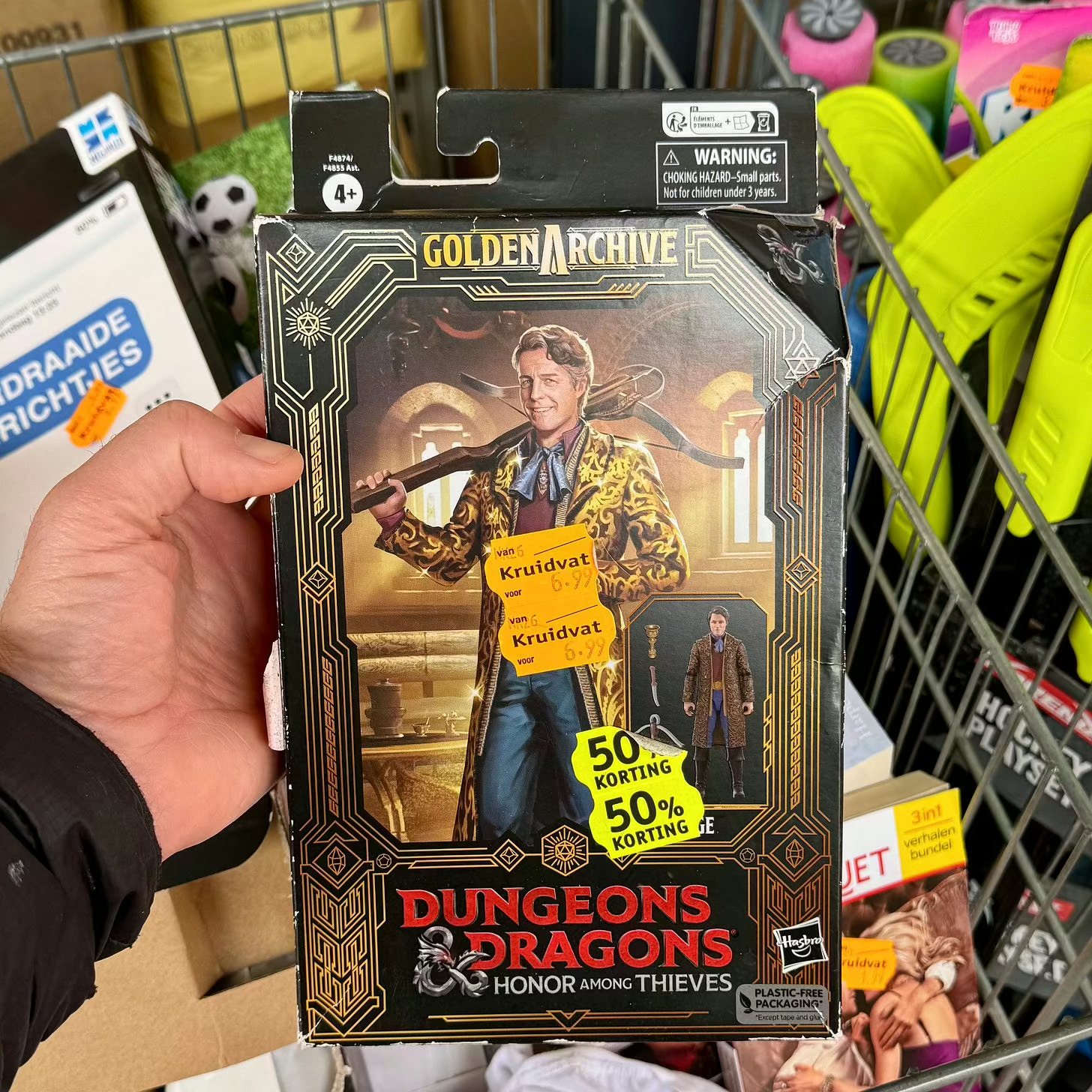
Logoff
Whitney and I are recording our interview with Taegan Goddard next week. I’m a huge fan of his work - both blog and podcast - and an even bigger fan of his “production function.”
I grew up in the era of and as a blogger. I wouldn’t say I’m a blogger anymore, but he sure is a blogger in a the best ways. Talking US politics with him isn’t really on the agenda - by the time the episode came out, it’d be stale. Plus, what is there to say? Read his blog instead. But, there’s plenty of ever-green topics, not to mention the afore mentioned production function.
Got any questions I should ask?
Suggested outro to glide into the weekend.
iPad Goat Ears
Relative to your interests
28 slightly rude notes on writing - “All emotions are useful for writing except for bitterness.” // “Somehow, whenever I finish a draft, my first few paragraphs almost always contain ideas that were necessary for writing the rest of the piece, but that aren’t necessary for understanding it.” // Lower down, that first part to delete is called "the windup." I call it "throat clearing." Either way, try to cut it and Mento-memo your way to the conclusion in the first sentence. This is, apparently, American-style, according to The Culture Map. Indeed!
A behind the scenes glimpse of the launch of GPT-4 - Fun anecdotes about OpenAI figuring out that ChatGPT was a big deal, and then marketing around it. // “Another little detail about the launch video is that we didn’t use titles for any of the OpenAI employees. Even to this day OpenAI is an incredibly flat organization. I watched a DeepMind video where every talking head had a title and it seemed like a caste system. While I don’t know if that’s really how it is there, I wanted to show that at OpenAI titles didn’t matter all that much. The one exception to titles were the people from Microsoft that appeared. I was given very specific instructions from them about titles. Microsoft even flew one of their execs down on a private jet so he could be in the video.” // Considering the goodwill and share value that Microsoft’s partnership with OpenAI likely brought, well worth it.
The Titan Who Couldn’t Let Go - Founder mode case study: “There’s a pattern here, and it’s bigger than Hughes. Obsession works–in short bursts, in narrow contexts, with clear feedback loops. But scale it up, let it harden into infrastructure, and it starts to rot the system from the inside. Hughes structurally disallowed any process he couldn’t control. That works in a cockpit. It fails in a boardroom.”
Getting things “done” in large tech companies - If the executives don’t know you did something cool, you didn’t do something cool. Legible.
VMware’s Kubernetes Evolution - a fuller history would be interesting to read.
Oxide’s Compensation Model: How is it Going? - You know, I bet it has the effect of encouraging people to focus on the product as the product instead of the product as their comp. // Of course, the next step is to publish and then equalize the cap-table, but, hey, we can’t go full socialist.
William Gibson - September 1997 interview.
It’s time we stopped asking for vases. - “Most people cram their AI prompts with so many rules that they predetermine the answer.”
Has DOGE missed its opportunity? - This is general advice for digital transformation, too. // And, on the actual focus,I mean: who could have predicted this outcome…
PepsiCo taps AWS to accelerate digital transformation, AI adoption | CIO Dive - ”Enterprises across industries are facing ballooning cloud bills as AI adoption drives up costs. Nearly 3 in 4 IT pros blamed the AI boom for ‘unmanageable’ cloud bills last year.” // When it comes to “we’re paying too much” things like this, I often wonder: do you mean something more like “unexpected” or even “we’re buying a lot because its useful.”
mobygratis - Free Moby music to empower your creative projects - Free to use as long as you don’t promote right wing politics or eating meat, dairy, etc.

Wastebook
“Let's not build that panopticon!” AI not as earth-deadly as previously thought?
“The first upload to my homepage (melonking.net) in 2016 was a story about a goat who trades his ears for an iPad, but recovers them again when he realises that the iPad can be broken in two, and remade into cyborg ears that fuse the best of what he had lost and what he had gained.” Finally, a practical use for iPads.
“It is a bit like modern Americans staking out Mount Vernon and destroying the risen corpse of George Washington.” M.T. Black.
“white male Christian cisgender macho MAGA man” Only lacking a geographic label.
“WE DIDN’T GENTRIFY SPITALFIELDS SO YOU COULD MICROWAVE YOUR DINNER.” Warren Ellis.
“In the wild Mantichora resemble the worst house cats, lazy, mercurial, and cruel, they torment their prey, sometimes even forgetting about it and letting it crawl away broken to die.” Not very friendly.
“Try to match the user’s vibe” System instructions.
“my pain wasn’t because I was weak or broken. It felt terrible because it was terrible.” ChatTherapist.
“I would rather have thinner relationships with ‘the perfect people for me’ than regular bear hugs and beer guzzlings with ‘people who are in the 87th percentile for me.’” Thinking percentiles.
Only experts fear what can replace them.
“The Politics of Symmetry” Taylor.
“Zavagor stole an amulet off of a drunk panda-man and got a cryptic message from his demonic patron: ‘The gargoyle needs iron. The circle is wooden.’” Not helpful.
“What happens when the bodies of children get older but stay the same?” Artful Dodgers.
“Vernacular institutions”: They are more useful than they are legible.
Charts
I like 100% area/bar charts. If you have enough periods of previous data, they’re great for showing a growing trends. Here’s a recent one:
And, here’s the chart that me like these 100% area charts, from 2012. It’s showing percent of units shipped per year per PC type (so, market share by unit, not revenue1):
The genius of this chart, though, is re-thinking what data belongs in the chart. At the time, thinking of “smart phones” as competitors to PCs was not normal. But, once you do think of them as the same - as we do now when it comes to this kind of strategic thinking - you see something incredibly dramatic. That chart tells a lot of interesting stories.
Conferences
Events I’ll either be speaking at or just attending.
Tanzu AI workshop, Palo Alto, CA, May 13th, speaking. CF Day US, Palo Alto, CA, May 14th, speaking. NDC Oslo, May 21st to 23rd, speaking. SREDay Cologne, June 12th, speaking (10% off with the code CLG10).
Logoff
Busy week next week. Travel to Palo Alto for two talks (see above), a podcast recording, and then all the usual.
That distinction is also an important one to me. When it comes to making money, market share by revenue is great, sure. You’re saying how much money you’re making versus your competitors. But, that doesn’t tell you how widely used something is. When you’re tracking trends, knowing units is much more important. You want to know how much something is happening, not just how much money people are making off it.
